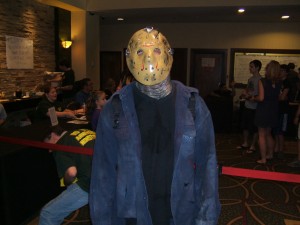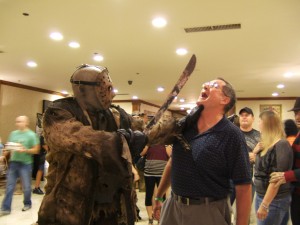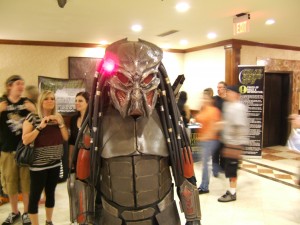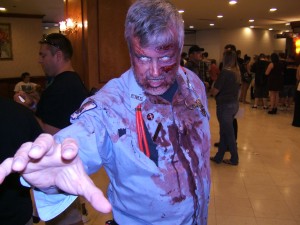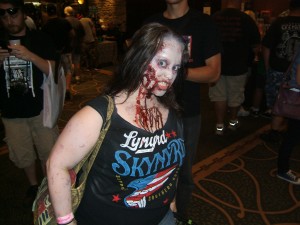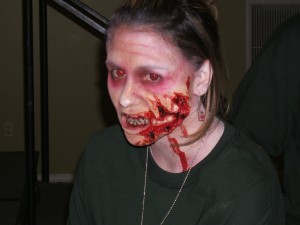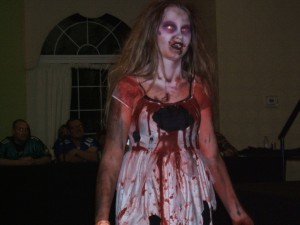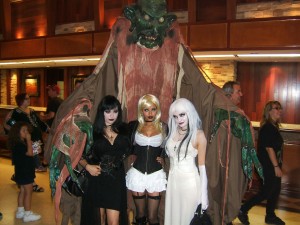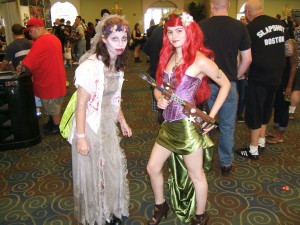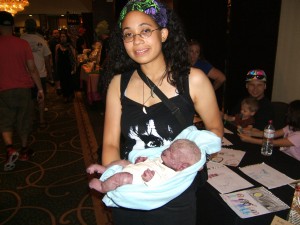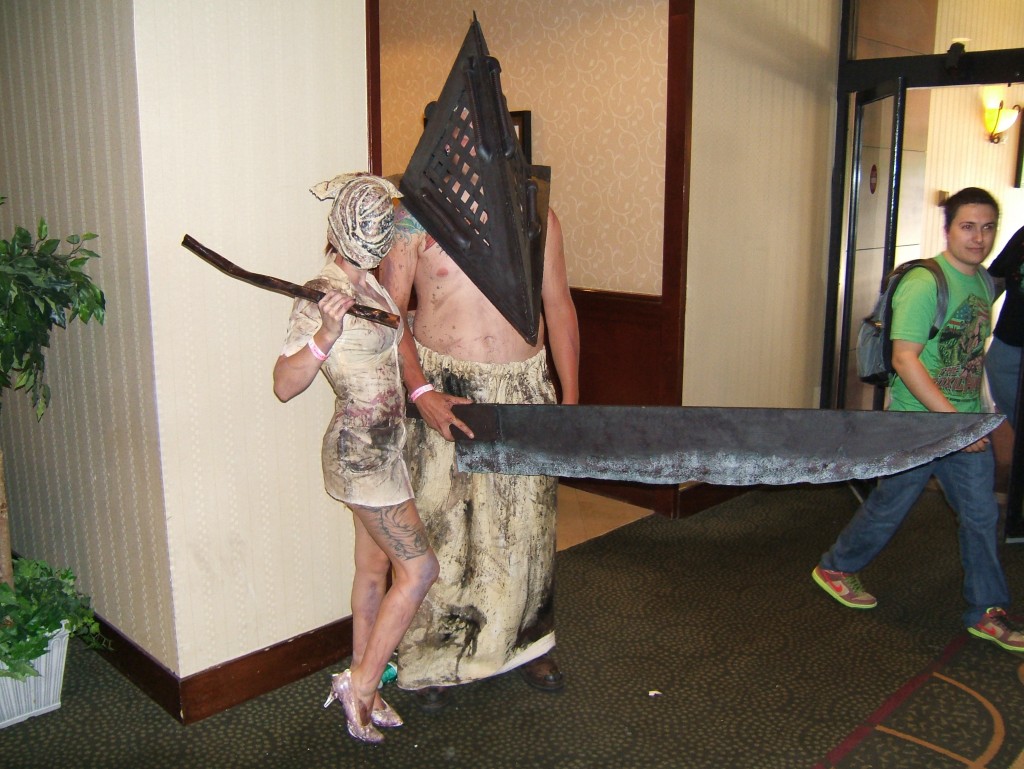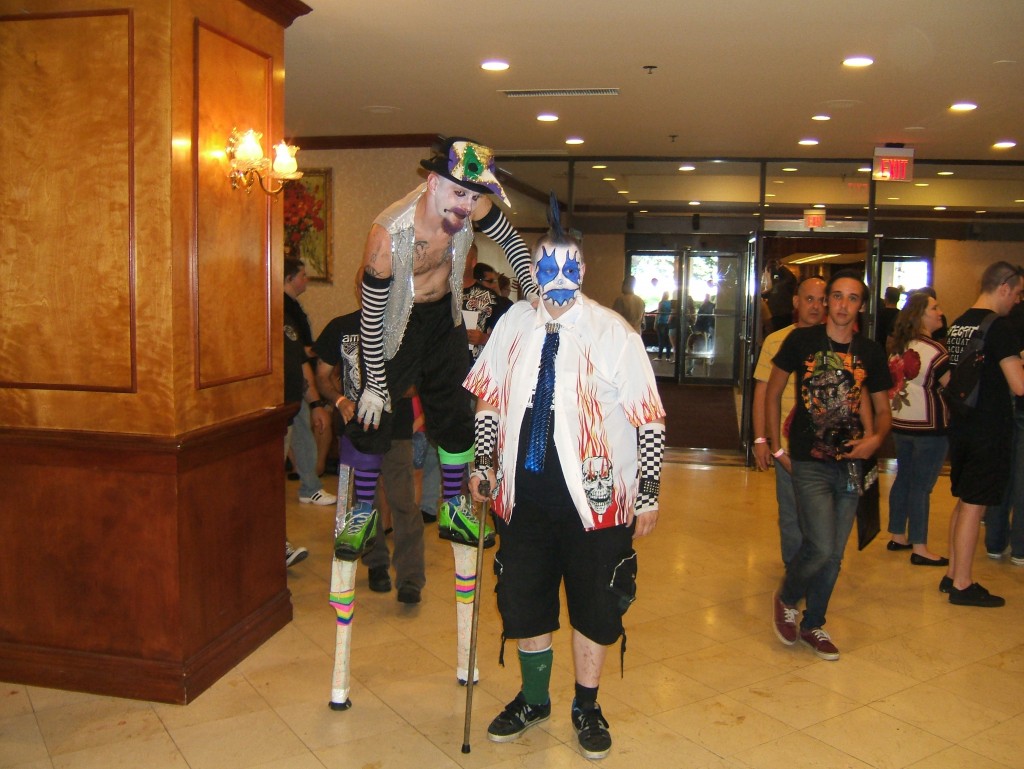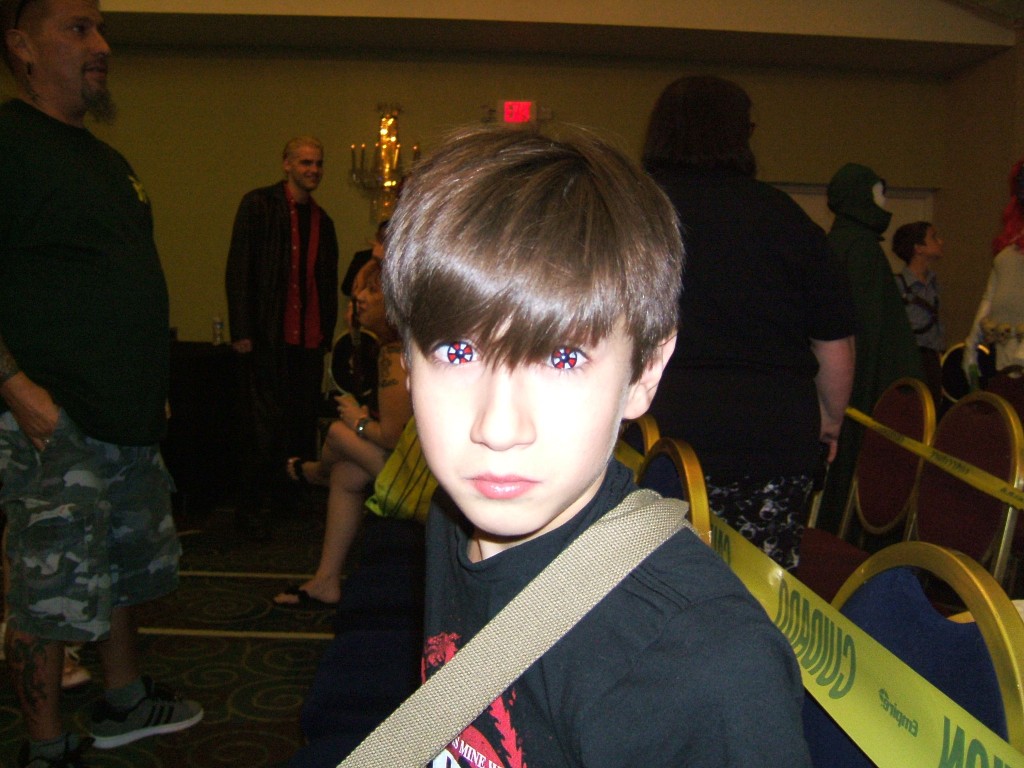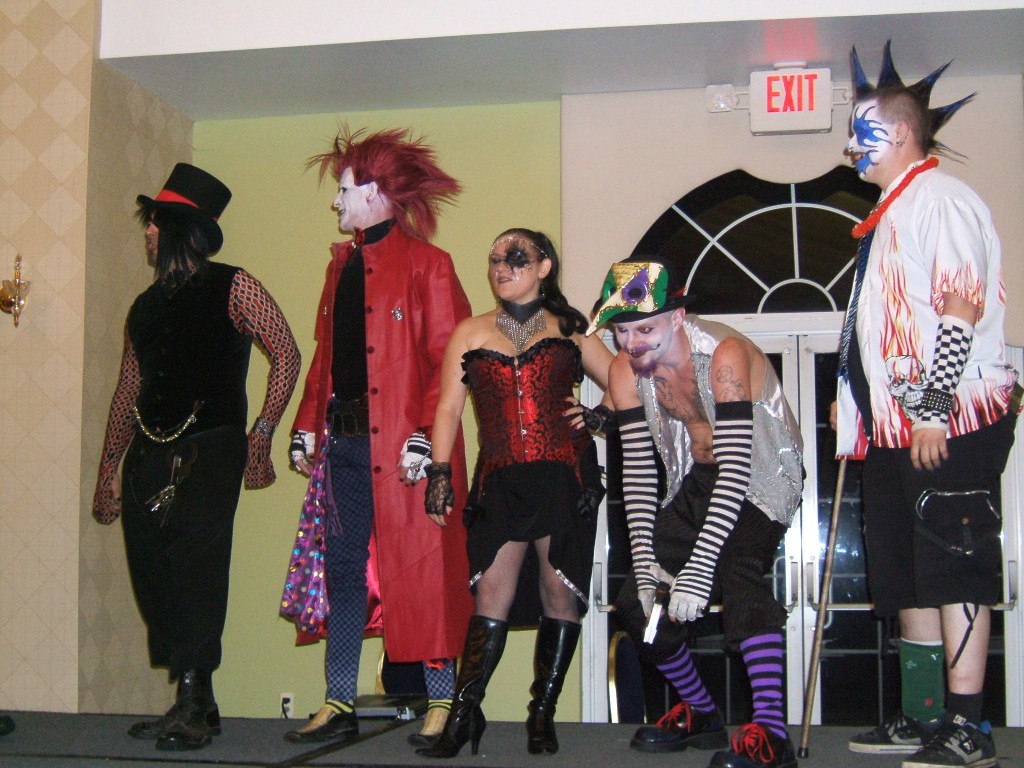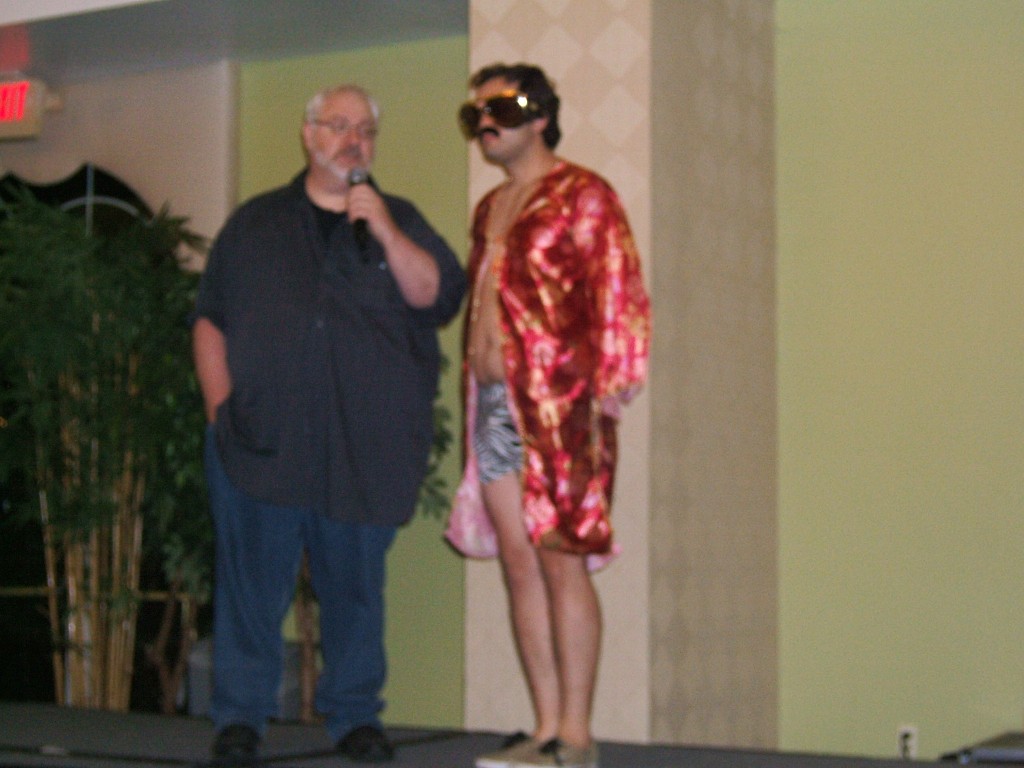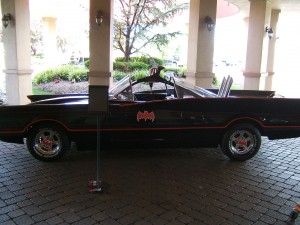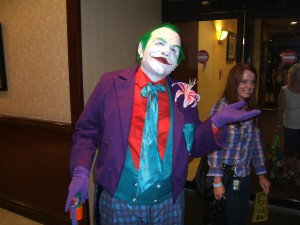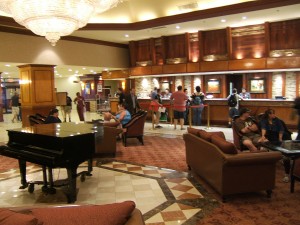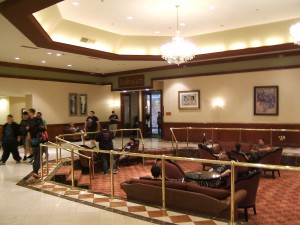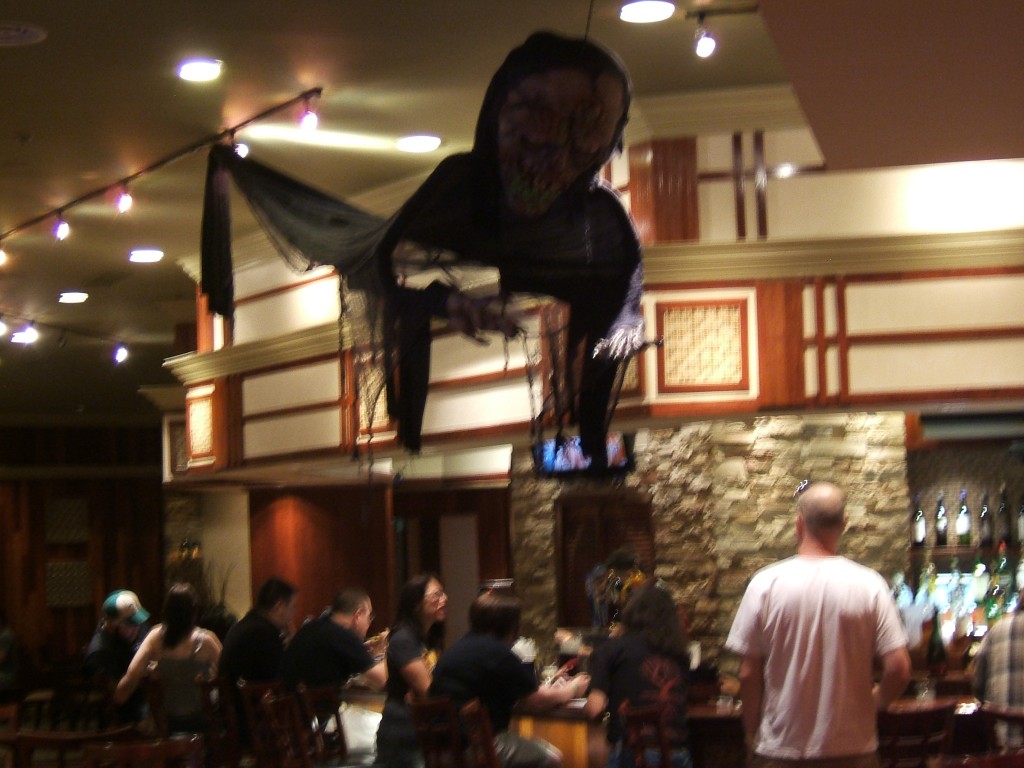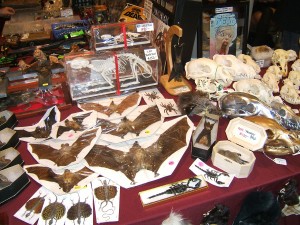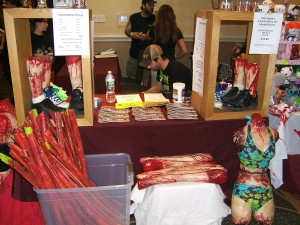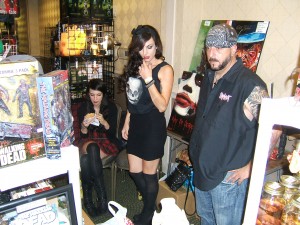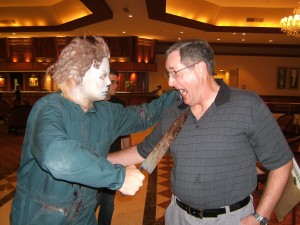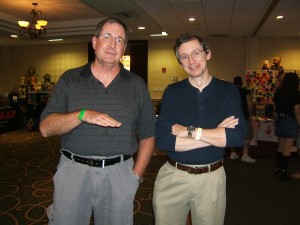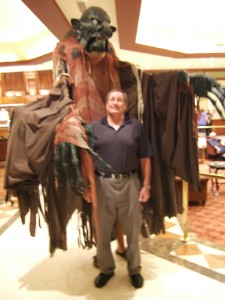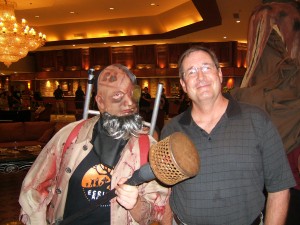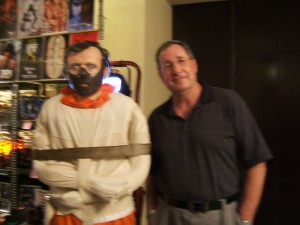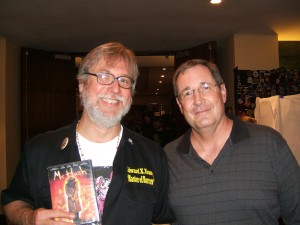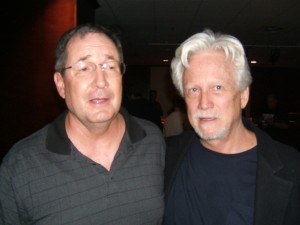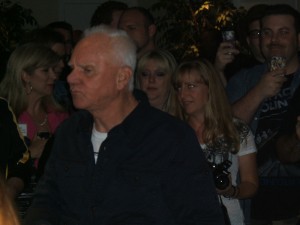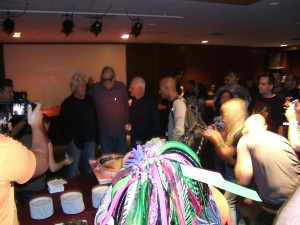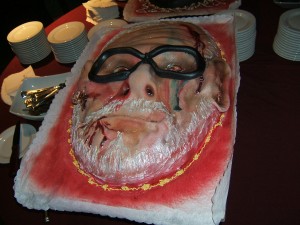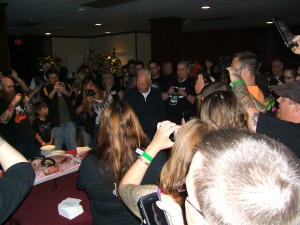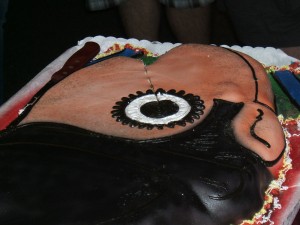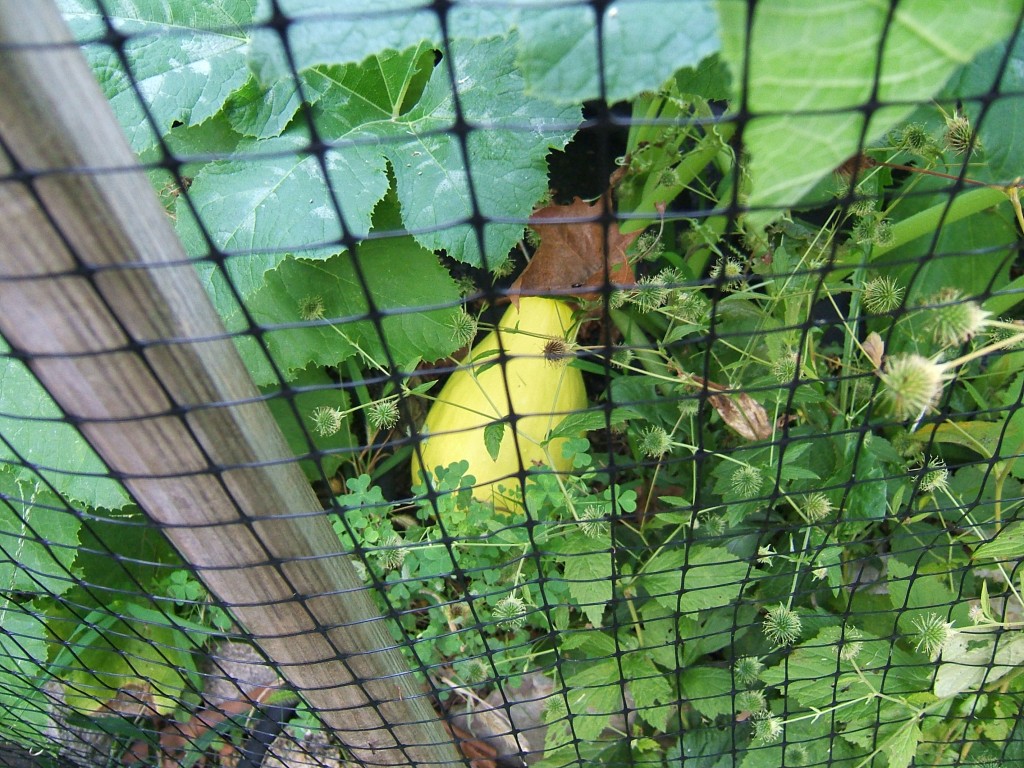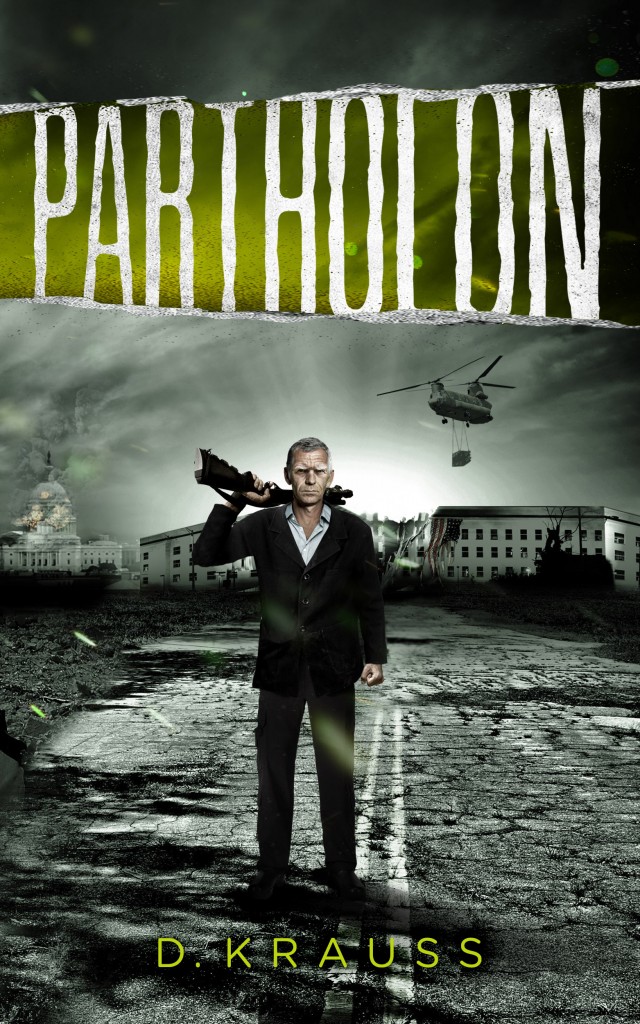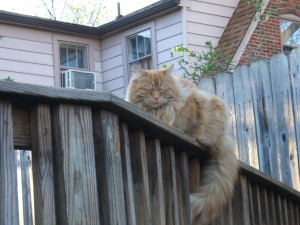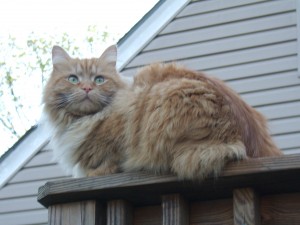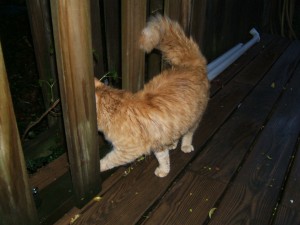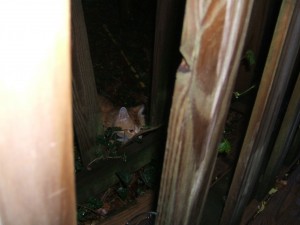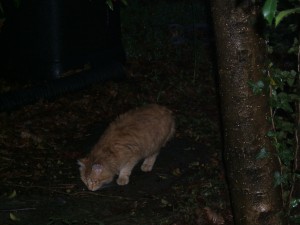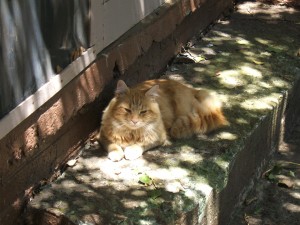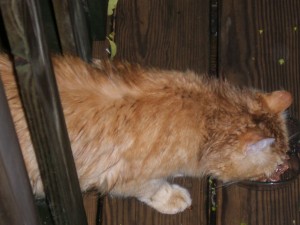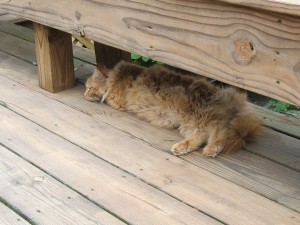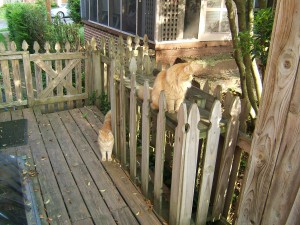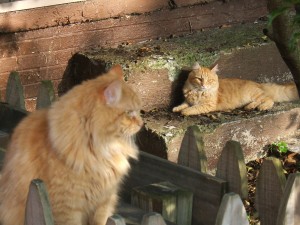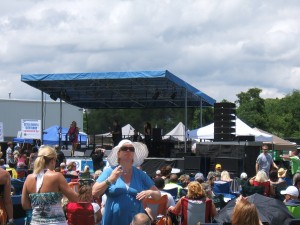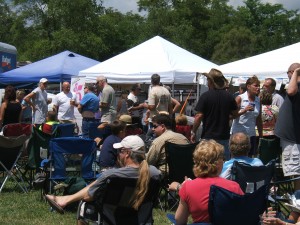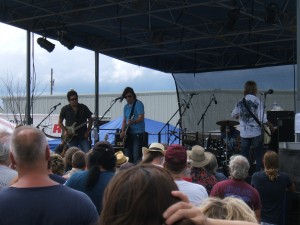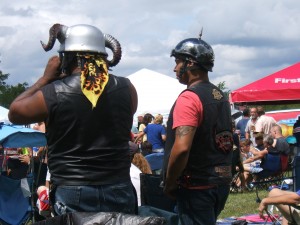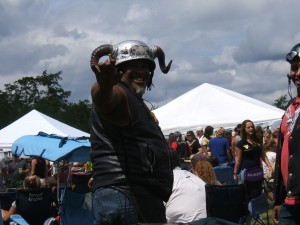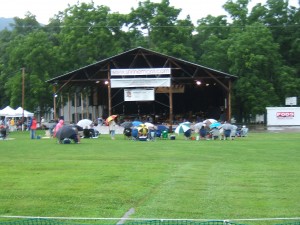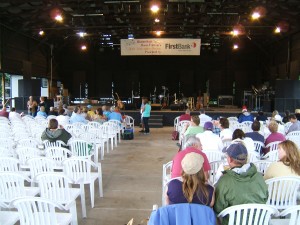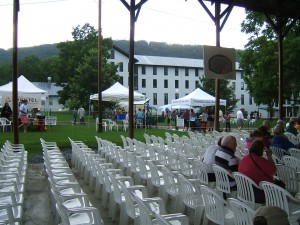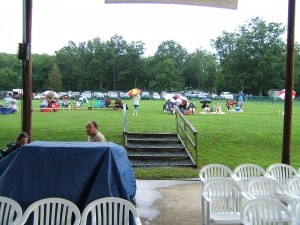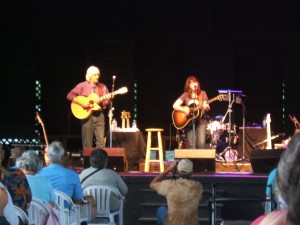I went. It’s only 75 miles or so away and the 150th of anything comes only once so how could any self-respecting self-proclaimed history buff miss it? Apparently not many, because there was a whole lot of people there, a lot more than I figured. I mean, 1-3 July are workdays; who’s running the country? But showing up on the 4th makes you a day late, so tell the boss to stuff it.
I camped at Caledonia State Park, about 15 miles east of Gettysburg, the site of Thaddeus Stevens’ ironworks (which Jubal Early took great delight in burning down). I’m too cheap to pay for a hotel and, besides, I’ve got all this camping gear taking up space in the garage so might as well put it to some use.  Yep, that’s a genuwine Civil War era reproduction canvas tent that I used back in the days when I was a Civil war re-enactor on a gun crew.
Yep, that’s a genuwine Civil War era reproduction canvas tent that I used back in the days when I was a Civil war re-enactor on a gun crew. 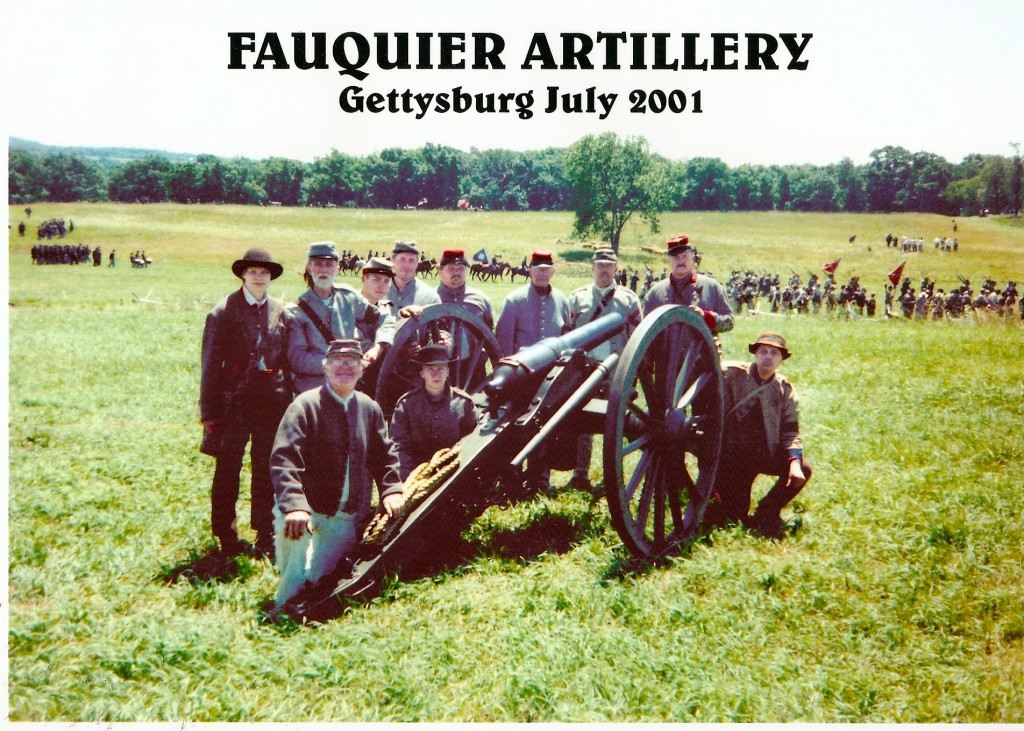
See if you can spot me.
Inside the tent is a genuwine Civil War era inflatable mattress that decided to spring a slow leak. Every night. So, I started out very comfortable, but about 0300, it turned into an inflatable hammock—my head and feet were in the air, and my back was planted solid on the ground. Rocky ground, at that. And, every time I moved, it threatened to overturn.
Life is an adventure.
Genuwine camp coffee. 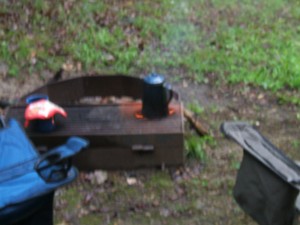
Genuwine son and his ultra modern throw-it-on-the-ground high tech tent. 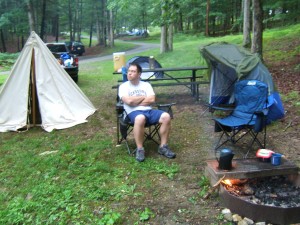
It rained the moment we got to the camp site, which meant we sat in the truck for an hour until it stopped, then ran out and put the tents up. We then went to Gettysburg.
Day Zero: I call it this because Jun 30th is the warm up for the main event, which started sort of unexpectedly on the morning of Jul 1st. We rode down Cashtown Pike, following the line of Lee’s approach and turned up Seminary Ridge because I was looking for a workaround. There is one thing you never do when visiting Gettysburg: drive downtown. Just. Don’t.
Well, Seminary Ridge was hopping. There were tents and re-enactors and food carts and all kinds of stuff going on. Intriguing. So we decided we’d come back after picking up some schedules at the Visitor Center, which was also hopping with all kinds of stuff going on, including a recreation of the Iron Brigade’s march from the Codori Farm to their positions on McPherson Ridge first thing tomorrow morning. The Iron Brigade? Cool!
We went back to Seminary Ridge and fell in, listening to concerts by a period group called Dearest Home, 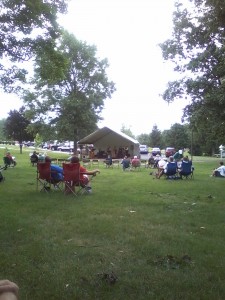 strolling around the chapel
strolling around the chapel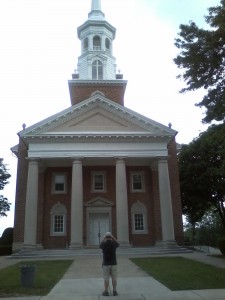 and the Lutheran Seminary,
and the Lutheran Seminary, 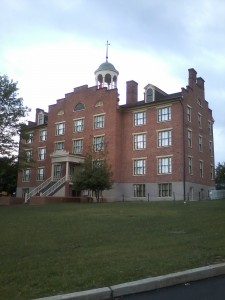 which, we discovered to our great delight, was going to open for tours starting 1 Jul. So, not only an Iron Brigade march, but a chance to see the famous cupola from which General Buford first surveyed the coming Confederates? Double cool!
which, we discovered to our great delight, was going to open for tours starting 1 Jul. So, not only an Iron Brigade march, but a chance to see the famous cupola from which General Buford first surveyed the coming Confederates? Double cool!
We walked about the encampments, which were manned by living history participants. Living history is different from re-enacting—LH’rs take on the identity of a specific Civil War participant, while re-enactors recreate an entire unit. We ran into a gentleman and his lady, 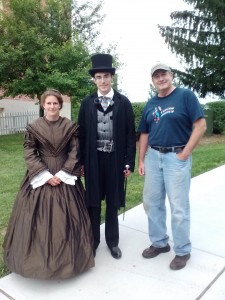 a Mexican Confederate on the run from Maximilian’s forces (that’s what he told us)
a Mexican Confederate on the run from Maximilian’s forces (that’s what he told us) 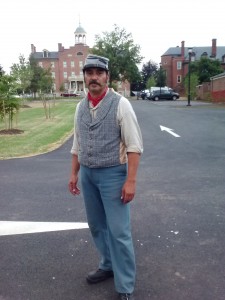 , and the bivouac of the Orphan Brigade,
, and the bivouac of the Orphan Brigade, 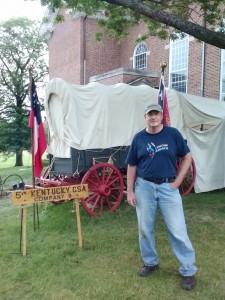 which was odd. It’s not like they had anything to do with Gettysburg or any of the battles in the east, but, as one LH’r explained, how can you miss this?
which was odd. It’s not like they had anything to do with Gettysburg or any of the battles in the east, but, as one LH’r explained, how can you miss this?
It was getting dark about then and I didn’t feel like cooking so we grabbed some chicken wings from KFC and headed back. Good thing, because about one minute after we arrived, it started raining. Hard. We sat under the sport umbrella/gazebo for about two hours, polishing off the wings, while it rained in buckets. Oceans. Rivers. Thunder and lightening and wind, oh my. I was pretty sure we were going to get flooded out. It stopped about 2300, long enough for me to run inside the tent and crawl into my rapidly deflating air mattress. About one minute after that, it started raining again, continuing all night. Sheesh.
Day 1: 1 Jul. Starting a campfire in the morning was a bit of a project, especially since there is no firewood available in the campground. None. You have to buy it from local stores, or glean what you can from the deadfall which, after last night’s deluge, was about as flammable as a rock. I couldn’t even get the leaves to light. I did manage to pull together enough less-soggy twigs to heat up some coffee, but definitely not enough to cook breakfast so we figured we’d be studly pioneer types and forgo it. Down a cuppa, and off to the Iron Brigade march.
There they were, forming up on Cemetery Ridge just behind the Codori Farm, 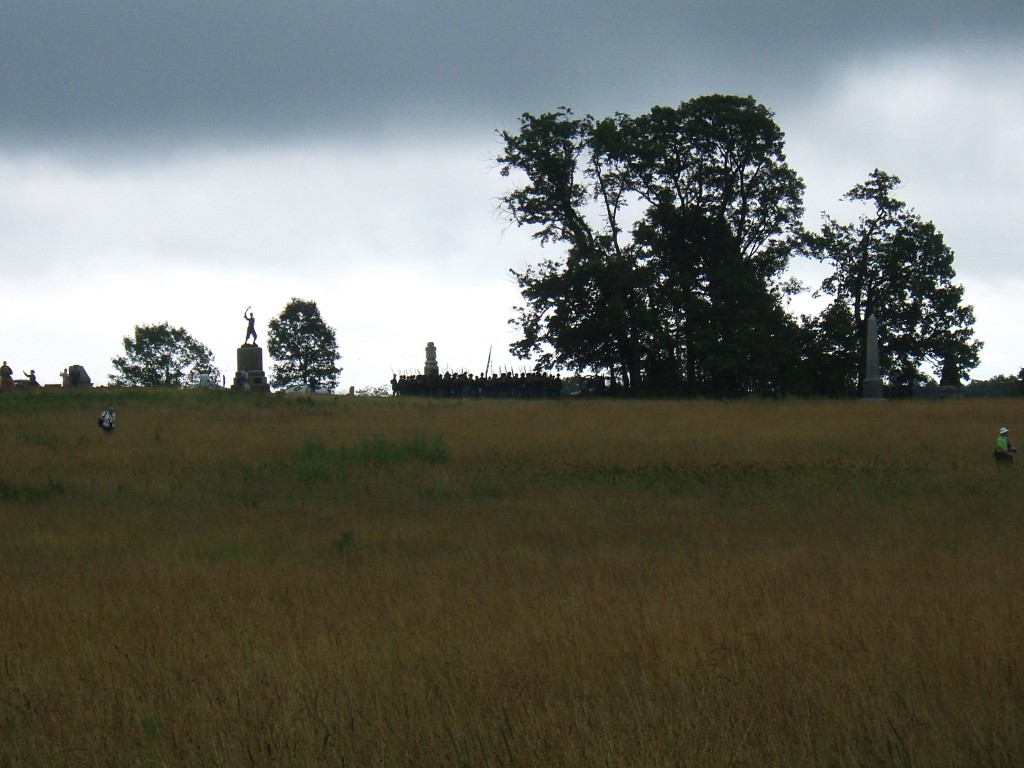 under the clouds and drizzle. Also forming up was a surprising number of civilians intent on marching with them, about 600, I’d say.
under the clouds and drizzle. Also forming up was a surprising number of civilians intent on marching with them, about 600, I’d say.  I thought maybe 30-50 would show up, not this large group, which pretty much outnumbered the brigade itself.
I thought maybe 30-50 would show up, not this large group, which pretty much outnumbered the brigade itself. 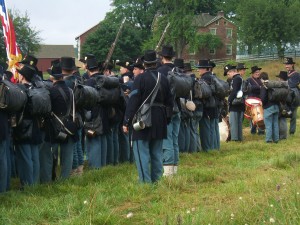 That was a bit problematic because the Brigade noncomms were tasked with forming us into columns of four and marching us behind the Brigade itself, quite the daunting prospect.
That was a bit problematic because the Brigade noncomms were tasked with forming us into columns of four and marching us behind the Brigade itself, quite the daunting prospect. 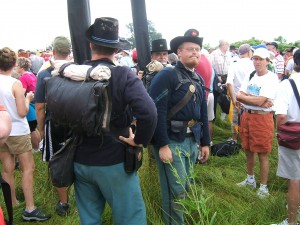 It was, as one person later described, quite akin to herding cats,
It was, as one person later described, quite akin to herding cats,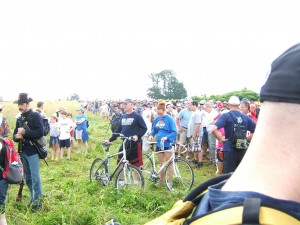 and came about in some semblance of military order primarily due to the efforts of this guy,
and came about in some semblance of military order primarily due to the efforts of this guy,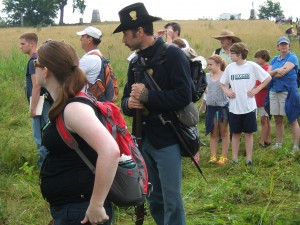 who was magnificent. Even led us in cheers along the way.
who was magnificent. Even led us in cheers along the way.
So, we’re off. 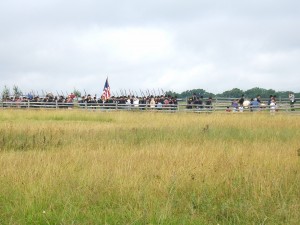
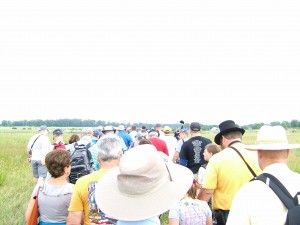
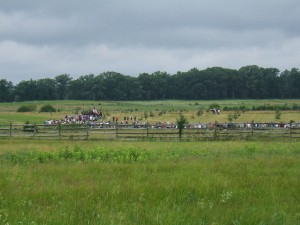 It was cool weather, no sun, a downright cold breeze blowing. Thank God, because this turned out to be downright grueling. About a mile into it, I was getting light headed and had the chest flutters. Possibly I should have eaten something. Even more possibly, I should have dropped out. But if you think I was going to wimp out in front of my son…rather drop dead there on the field. Which seemed like a distinct possibility, at a couple of points. If it had been five degrees hotter, I’d’ve been another Gettysburg casualty.
It was cool weather, no sun, a downright cold breeze blowing. Thank God, because this turned out to be downright grueling. About a mile into it, I was getting light headed and had the chest flutters. Possibly I should have eaten something. Even more possibly, I should have dropped out. But if you think I was going to wimp out in front of my son…rather drop dead there on the field. Which seemed like a distinct possibility, at a couple of points. If it had been five degrees hotter, I’d’ve been another Gettysburg casualty.
View from the back of the line. 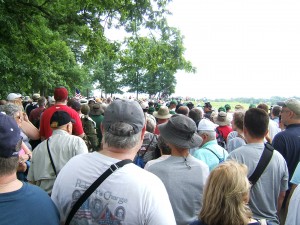
Finally, two hours later (we stopped a couple of times so Park Rangers could point out some interesting aspects of the march, and to gulp water. And catch breath) we reached the place where the Iron Brigade charged McPherson Ridge, 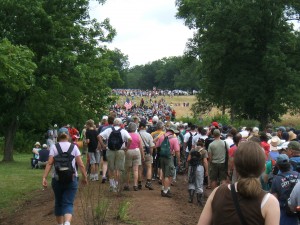 General Reynolds urging them to get “those people” out of the woods. Which turned out to be his last words, since he was felled moments later by a Confederate sniper. It was, also, the last march and the last charge of the Iron Brigade, which took so many casualties in those woods that they pretty much evaporated, sacrificing themselves to buy time for the Union. Hoo rah, mates.
General Reynolds urging them to get “those people” out of the woods. Which turned out to be his last words, since he was felled moments later by a Confederate sniper. It was, also, the last march and the last charge of the Iron Brigade, which took so many casualties in those woods that they pretty much evaporated, sacrificing themselves to buy time for the Union. Hoo rah, mates.
My son and I rushed back to the Seminary afterwards so we could beat the crowd for cupola tour tickets, grabbing a couple of slots for 3:15, almost the last ones available. People wanted in. We got lunch (breakfast) at a great hamburger coach parked near the corner and visited the area where Perrin’s brigade was slaughtered as they were driving the Union off Seminary Ridge.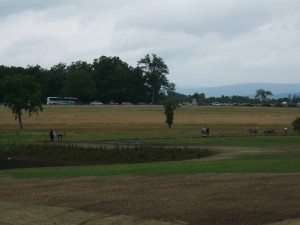 We caught naps on the wet ground while listening to a Union regimental band
We caught naps on the wet ground while listening to a Union regimental band  for a while,
for a while, 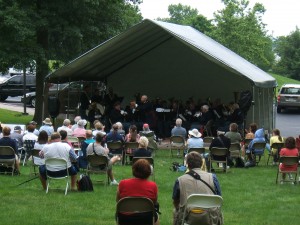 and just toured about.
and just toured about. 
Great dog. 
Great dress. 
Great Caesar’s Ghost!  Dad, what were you thinking?
Dad, what were you thinking?
The bellows guy is either hard at work or adjusting the blacksmith’s headband. 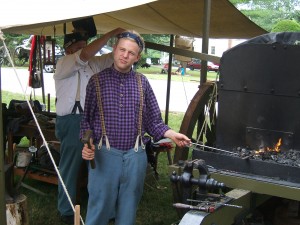
Them LH’rs eat good. 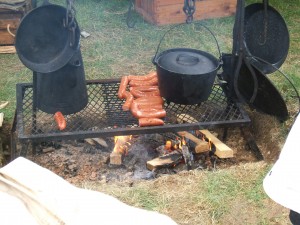

Ten year old with a drum. 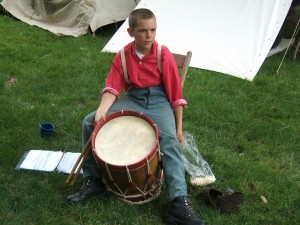 Dad, what were you thinking?
Dad, what were you thinking?
Parents are going to regret this. 
Then it was cupola tour time. 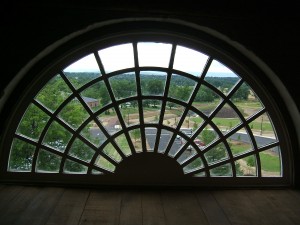
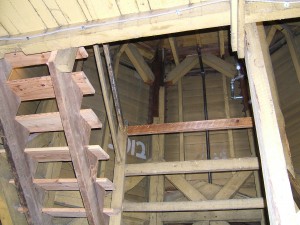
The views were spectacular. 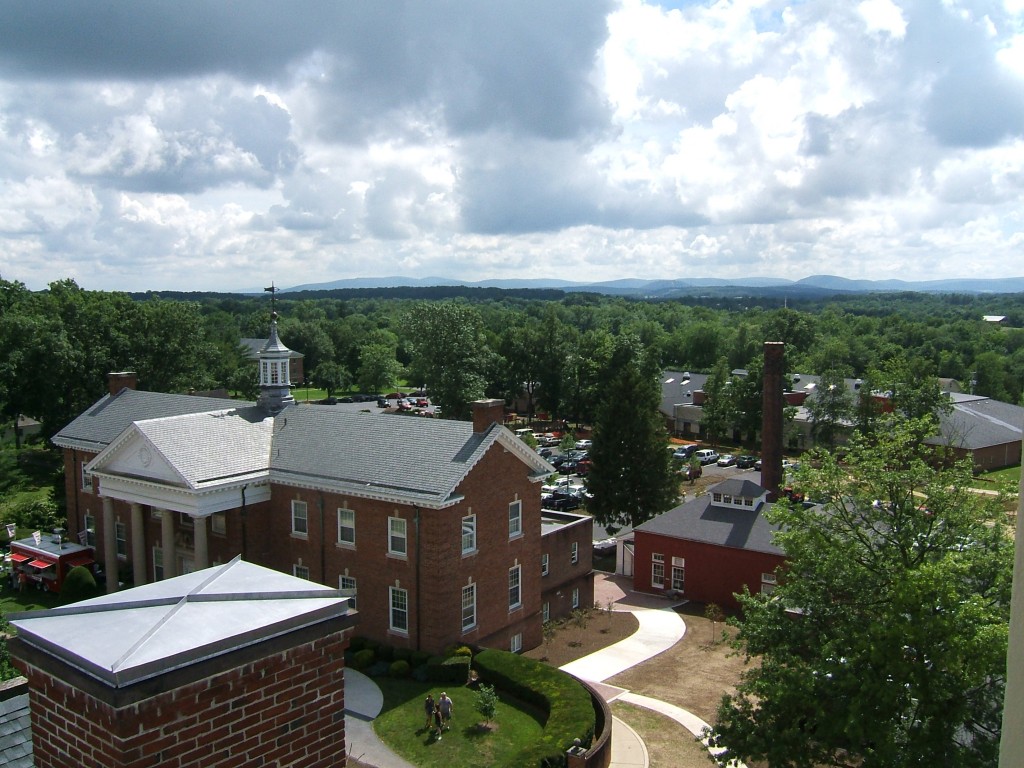
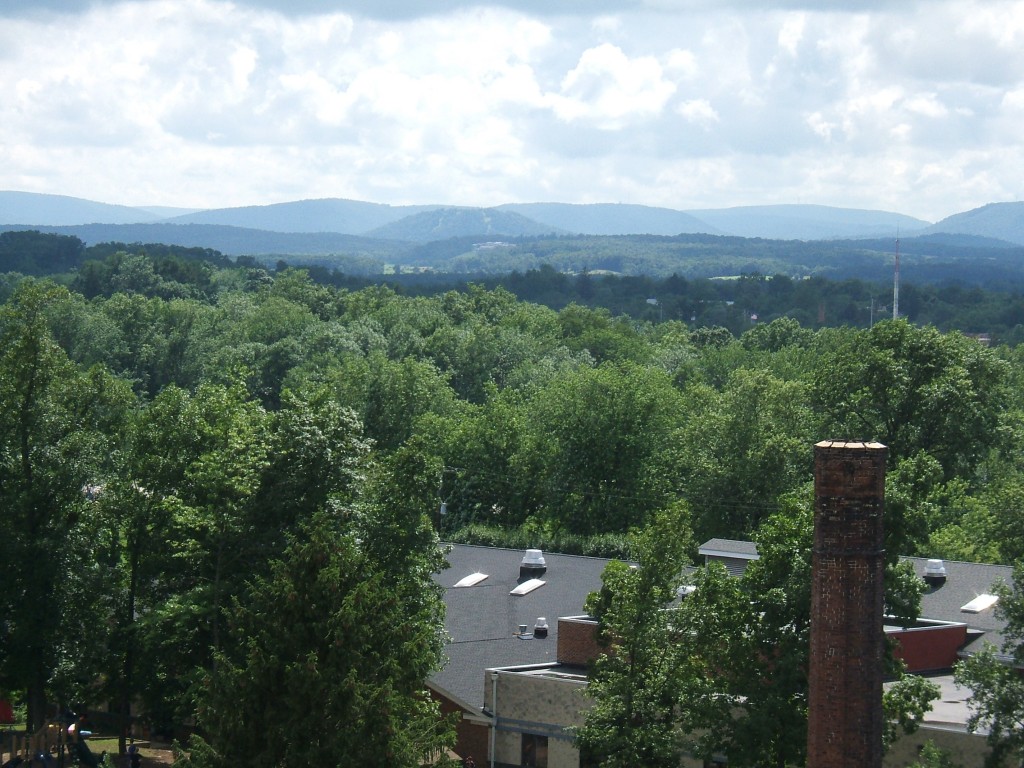
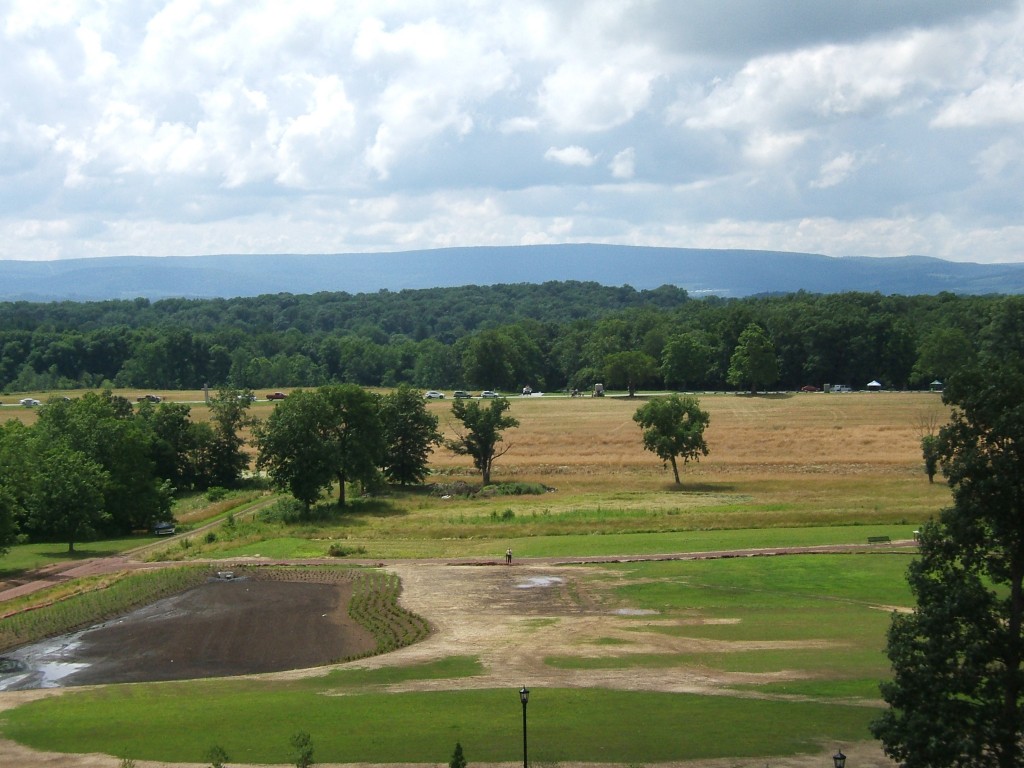

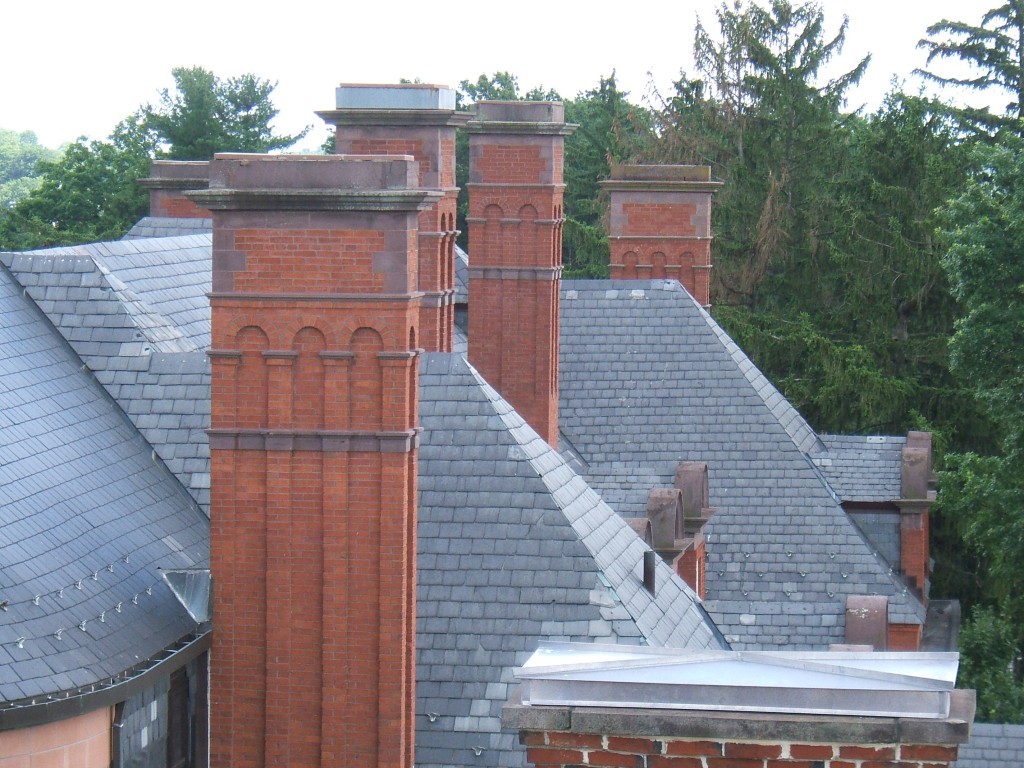
Quite satisfying. 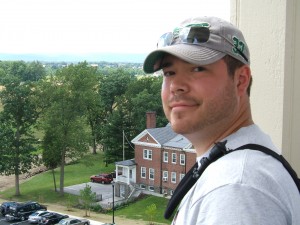
But, also, myth-busting. The guide told us there’s only a 50/50 chance that Buford actually scaled the cupola to look around. His signal officer, definitely, but Buford? Maybe not. And there is no way he and Reynolds held a conversation between cupola and the ground below, as depicted in the movie, Gettysburg. 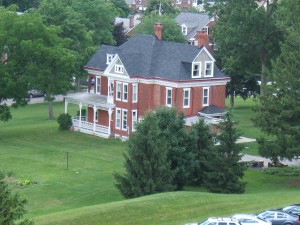 Unless Buford had a powered megaphone.
Unless Buford had a powered megaphone.
We then had to walk back two miles to get the truck, cutting through neighborhoods and parks, and I ended up feeling like this: 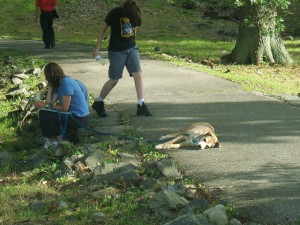 so we grabbed something to eat, went back to the campsite (after buying firewood), got a scrawny fire going, showered, then passed out.
so we grabbed something to eat, went back to the campsite (after buying firewood), got a scrawny fire going, showered, then passed out.
And it rained all night, necessitating lockdown. 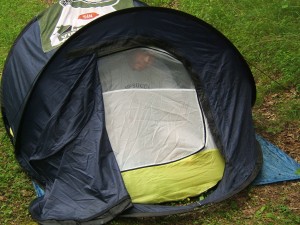
Day 2: Jul 2. There was a march through Devil’s Den scheduled at 1330 so, after a breakfast of cornbread, chicken, and scrambled eggs, courtesy of moi and my stubborn insistence on a campfire and food, we headed back to McPherson Ridge to finish up some 1st Day’s Battle events. We went back to the Iron Brigade field and the spot where Reynolds was killed, and then into the woods where the rest of the Brigade perished.
and then into the woods where the rest of the Brigade perished. 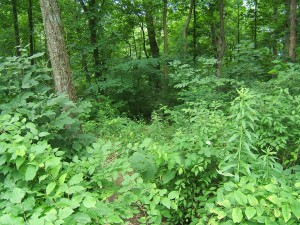 Pretty thick going, and a nasty place for a fight.
Pretty thick going, and a nasty place for a fight.
Someone rendered tribute. 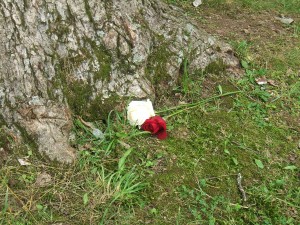
We then followed the path of the 6th Wisconsin, which was detached from the Iron Brigade to the other side of the field 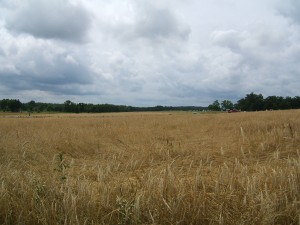 (the far distance is the location they marched from) where brigades of Confederates were attempting to get behind Buford by using a very steep railroad cut.
(the far distance is the location they marched from) where brigades of Confederates were attempting to get behind Buford by using a very steep railroad cut. 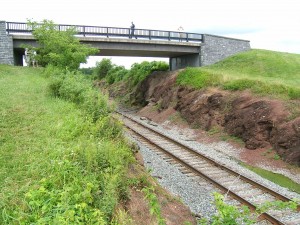 The Confederates didn’t get far.
The Confederates didn’t get far. 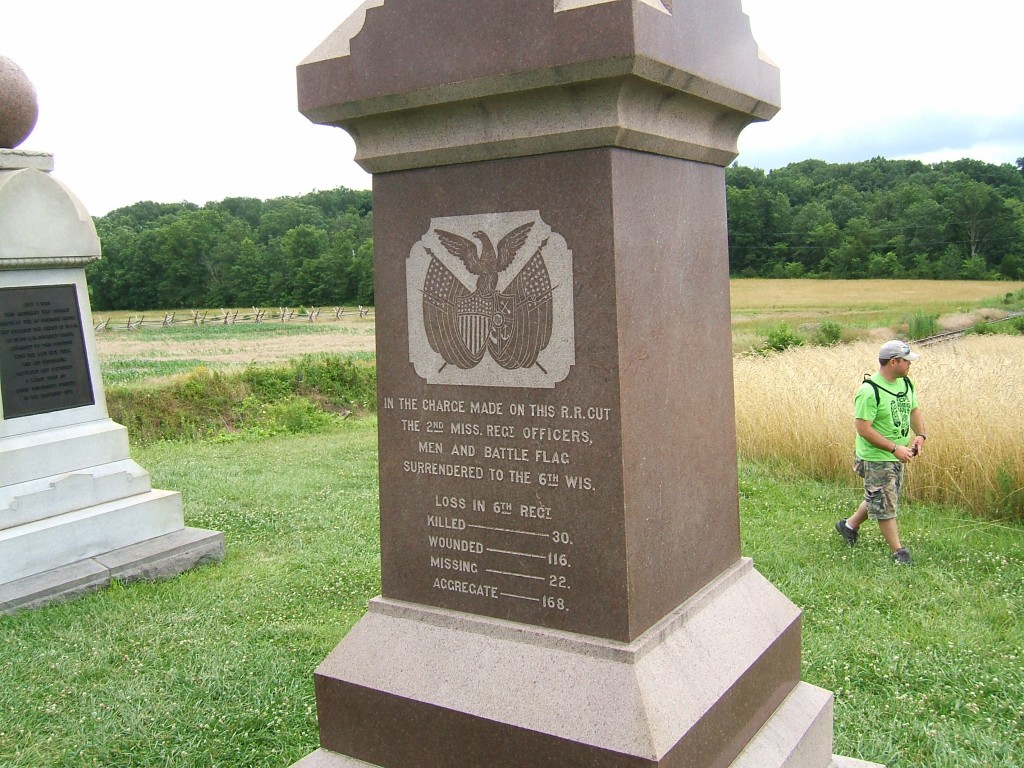
We then drove over to Devil’s Den and found pretty much the same 600 people from the Iron Brigade march waiting there.  Tenacious group. The Park Ranger briefed us
Tenacious group. The Park Ranger briefed us 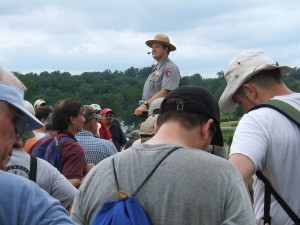 and we were on our way.
and we were on our way. 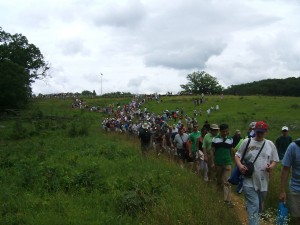
Another cool, misty breezy day, thank God again, because this march, although not even half the distance, was every bit as grueling. It involved an incredible amount of scrambling over very large boulders, and my old man’s body protested every rocky step of the way. I felt like this guy. 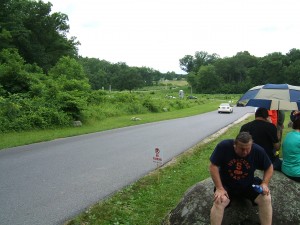
We started at the triangular field,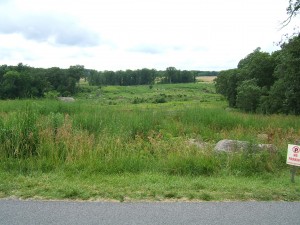 over which a whole boatload of quite perturbed Texans and Arkansans came pouring to scale the Den, cross the Wheatfield and launch straight at Little Round Top, with various New York and Pennsylvania units objecting. Without going into details, it was bloody awful.
over which a whole boatload of quite perturbed Texans and Arkansans came pouring to scale the Den, cross the Wheatfield and launch straight at Little Round Top, with various New York and Pennsylvania units objecting. Without going into details, it was bloody awful.
Along the way, we ran into the Union Chief of Artillery, BGen Henry Hunt, a Calvary officer dressed for the prom, and a vivandiare.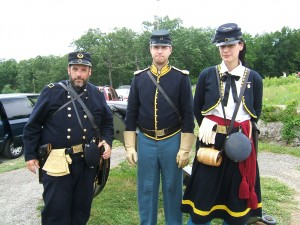 A member of Kershaw’s Brigade held his position on top of the Den.
A member of Kershaw’s Brigade held his position on top of the Den. 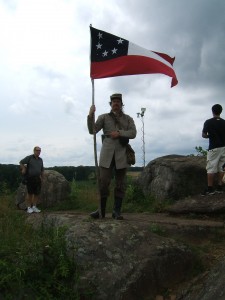 While a member of the 6th New Jersey was relaxing among the very rocks where his predecessors held up the screaming Rebel hordes long enough for Col Strong Vincent to take Little Round Top.
While a member of the 6th New Jersey was relaxing among the very rocks where his predecessors held up the screaming Rebel hordes long enough for Col Strong Vincent to take Little Round Top. 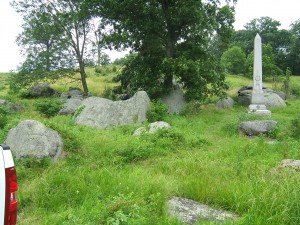
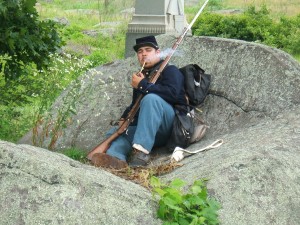 New Jersey boys getting into a dustup and holding their own. Waddya expect?
New Jersey boys getting into a dustup and holding their own. Waddya expect?
We then went to the Peach Orchard and the Wheatfield 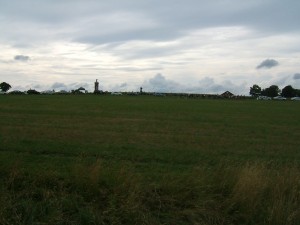 to follow the feckless Dan Sickles‘ attempt to lose the entire war. I love Dan Sickles. The guy was an effin’ screwup, a fraud, a mediocrity, a criminal, the first person to successfully use the temporary insanity defense in a trial for murder, treated his family like crap, yet still, is credited by some with winning the Battle of Gettysburg. Inspiring. There’s hope yet that my own, rather mediocre, writing career will one day blossom under some similar misperception. I could not leave the field without paying special homage to Dan Sickle’s missing leg.
to follow the feckless Dan Sickles‘ attempt to lose the entire war. I love Dan Sickles. The guy was an effin’ screwup, a fraud, a mediocrity, a criminal, the first person to successfully use the temporary insanity defense in a trial for murder, treated his family like crap, yet still, is credited by some with winning the Battle of Gettysburg. Inspiring. There’s hope yet that my own, rather mediocre, writing career will one day blossom under some similar misperception. I could not leave the field without paying special homage to Dan Sickle’s missing leg. 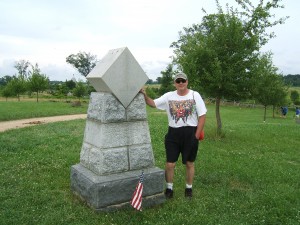
The next (exhausting) event was a tour of the Culp’s Hill/Cemetery Ridge portion of the 2nd Day’s battle, a curiously unknown aspect which I had, curiously, ignored on previous visits. We had to pass through the National Cemetery to get there, where the Union dead were gathered and interred and then, later, President Lincoln showed up and gave some speech. 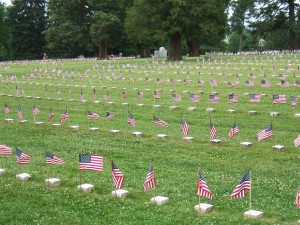
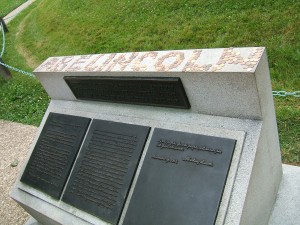
We got to West Cemetery Hill and, wouldn’t you know, the same 600 people were there waiting? 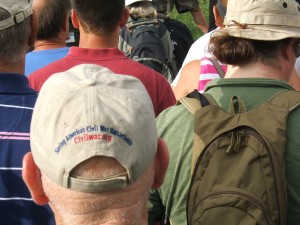
Cemetery Hill 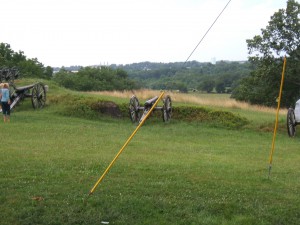
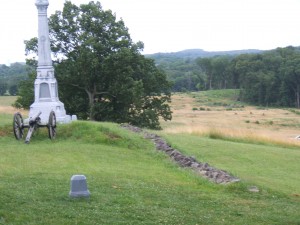 is where the remnants of the Iron Brigade ended up after their dismantling on McPherson Ridge, and the poor guys then had to endure one of the most confusing, baffling goat-rope types of fights any solider ever had. It was, as the Park Ranger described, a microcosm of the entire Battle itself, with routs and charges and confusion and night fighting and even a Pickett’s-charge like breakthrough by the Confederates.
is where the remnants of the Iron Brigade ended up after their dismantling on McPherson Ridge, and the poor guys then had to endure one of the most confusing, baffling goat-rope types of fights any solider ever had. It was, as the Park Ranger described, a microcosm of the entire Battle itself, with routs and charges and confusion and night fighting and even a Pickett’s-charge like breakthrough by the Confederates.
Essentially (and with much glossing over of detail), Ewell sent Hays from this field 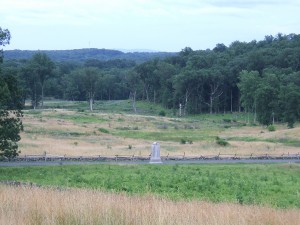 up this slope
up this slope 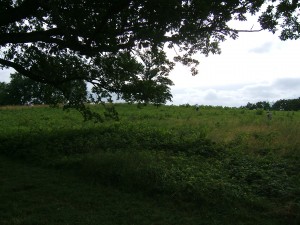 while taking fire on their flank from a bunch of very happy Union gunners on Stevens Knoll
while taking fire on their flank from a bunch of very happy Union gunners on Stevens Knoll 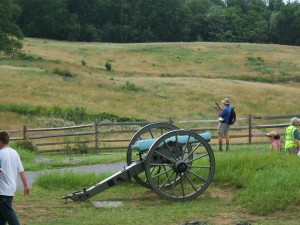 to attack a group of very unhappy Union soldiers on top of the hill who were thinned out because Meade had to send most of the troops from there to rescue that idiot Sickles who was getting mauled in the Wheatfield (see how this all ties together?). Hays actually made it
to attack a group of very unhappy Union soldiers on top of the hill who were thinned out because Meade had to send most of the troops from there to rescue that idiot Sickles who was getting mauled in the Wheatfield (see how this all ties together?). Hays actually made it 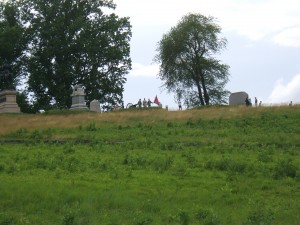 but had to run away when Ewell called off a supporting attack. Members of the 2nd Maryland color guard
but had to run away when Ewell called off a supporting attack. Members of the 2nd Maryland color guard  didn’t have very nice things to say about Ewell.
didn’t have very nice things to say about Ewell.
We then took a quick look at the original Evergreen Cemetery, 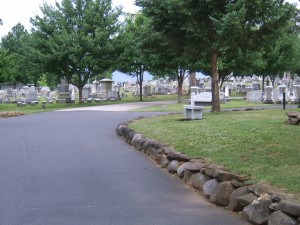 which is overshadowed by the National Cemetery next door.
which is overshadowed by the National Cemetery next door. 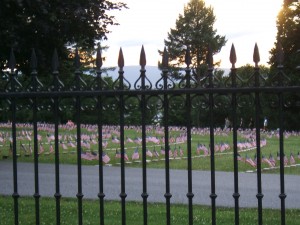
This pretty much says it all. 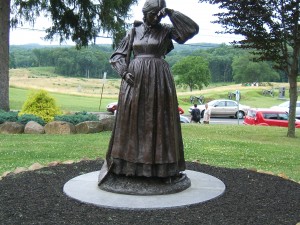
The grave of General James Gettys, the town’s namesake. 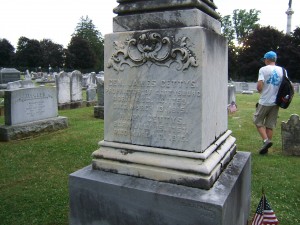
Other interesting graves, including a local who fought for the Confederacy and famous local names. 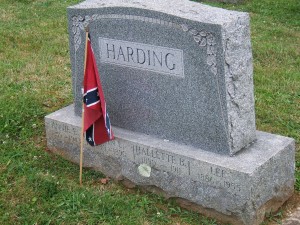
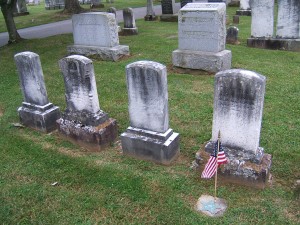
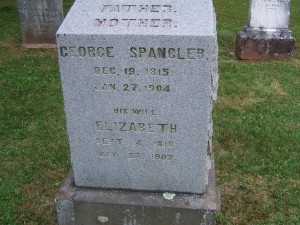 And this one:
And this one: 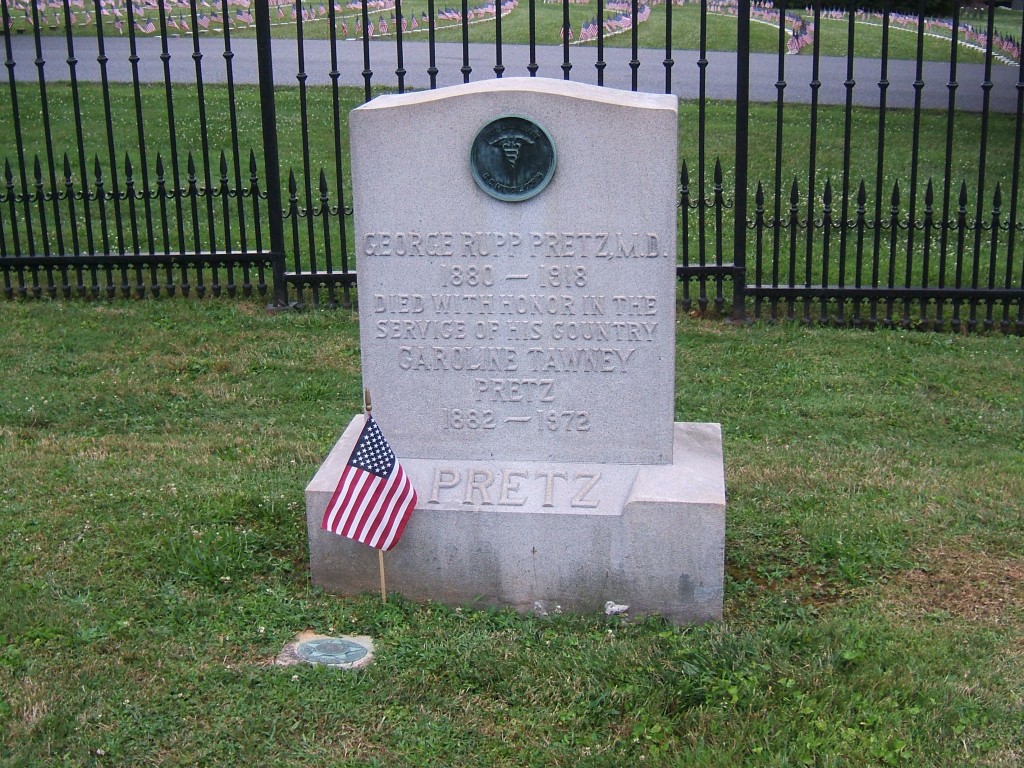 Dr. Pretz, killed in WW1, his widow passing 54 years later.
Dr. Pretz, killed in WW1, his widow passing 54 years later.
End of the day in the National Cemetery, 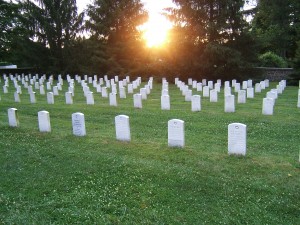
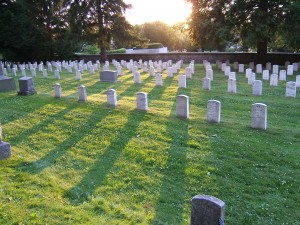 capped by this stunning celestial event:
capped by this stunning celestial event: 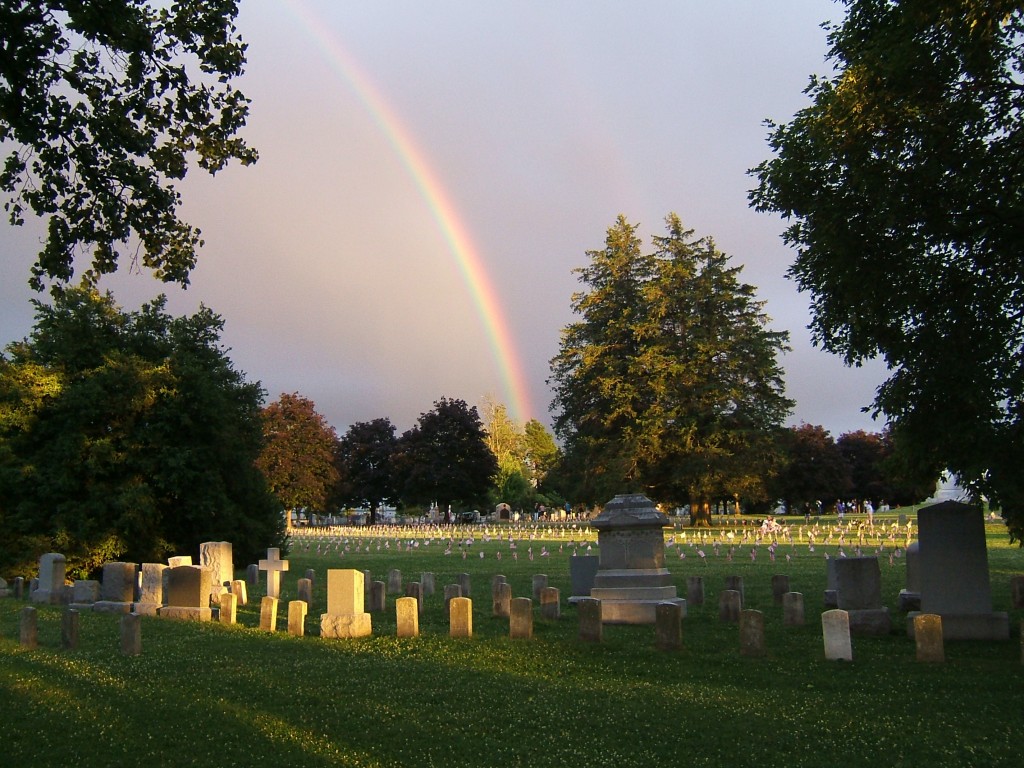

Awesome
Day 3, Jul 3: Rained all night, again, but, this time, with the help of Matchlight charcoal, we had another rousing breakfast of cornbread, the leftover chicken, and eggs embellished with onions and peppers. I am the camp gourmet. We were leisurely because the only event of the day was the much anticipated Pickett’s Charge at 1530. Participants could chose to be Confederates and march across the field, or choose to be Union and wait behind the stone wall. We elected to be Union. I’d pretty much had my fill of running across broken ground. Besides, it was scheduled to be actually hot today and, well, discretion is the better part of valor.
So we took our leisurely selves over to Gettysburg about noon and…holy Hannah, where in the blue blazes did all these people come from? Smack myself in the forehead: of course! It’s July 3rd, so a lot of people have taken off in conjunction with tomorrow’s holiday and, besides, it’s Pickett’s Charge—everyone wants to do that. I found a pretty decent parking spot on a side street we had recon’d earlier in the week, so got to the site relatively unscathed. We spent time searching for the location of Woodruff’s battery  , which I thought a good spot to observe the festivities since Woodruff had taken Pickett in the flank, pretty much devastating Davis’ portion of the Charge.
, which I thought a good spot to observe the festivities since Woodruff had taken Pickett in the flank, pretty much devastating Davis’ portion of the Charge. 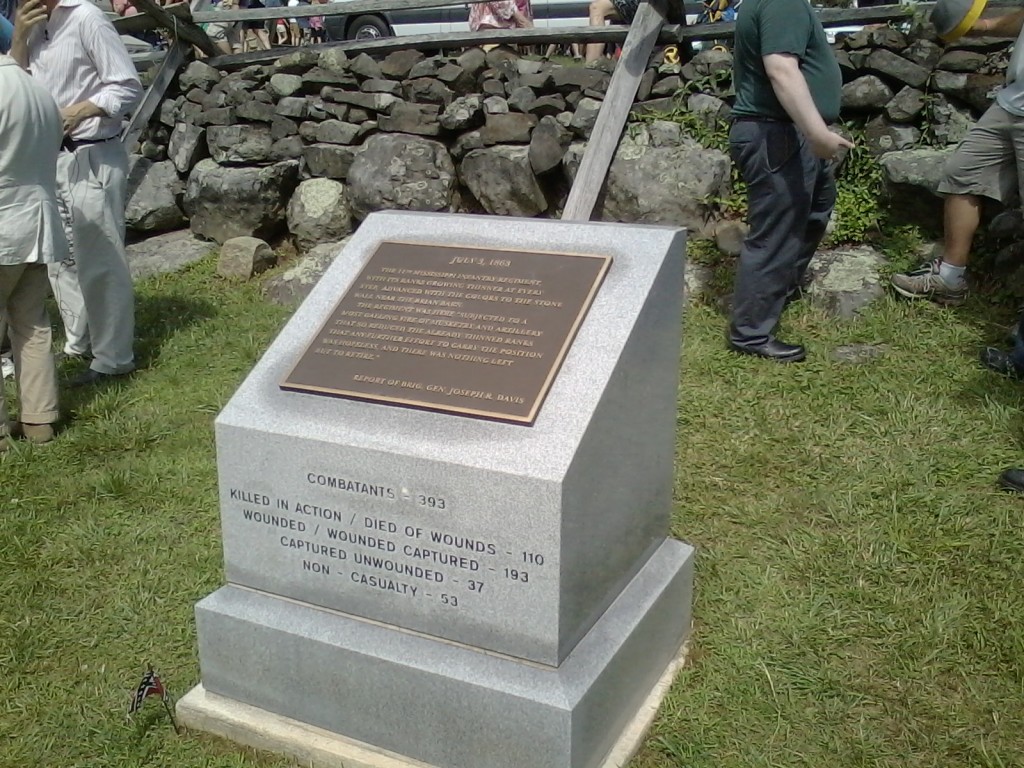 I didn’t find the exact location until after the events, but close enough for government work.
I didn’t find the exact location until after the events, but close enough for government work.
The “herding cats” syndrome was in full swing for this event, the Charge somehow starting around 1500, thirty minutes early, by spontaneous and unexpected movement from the Confederate side of the field. 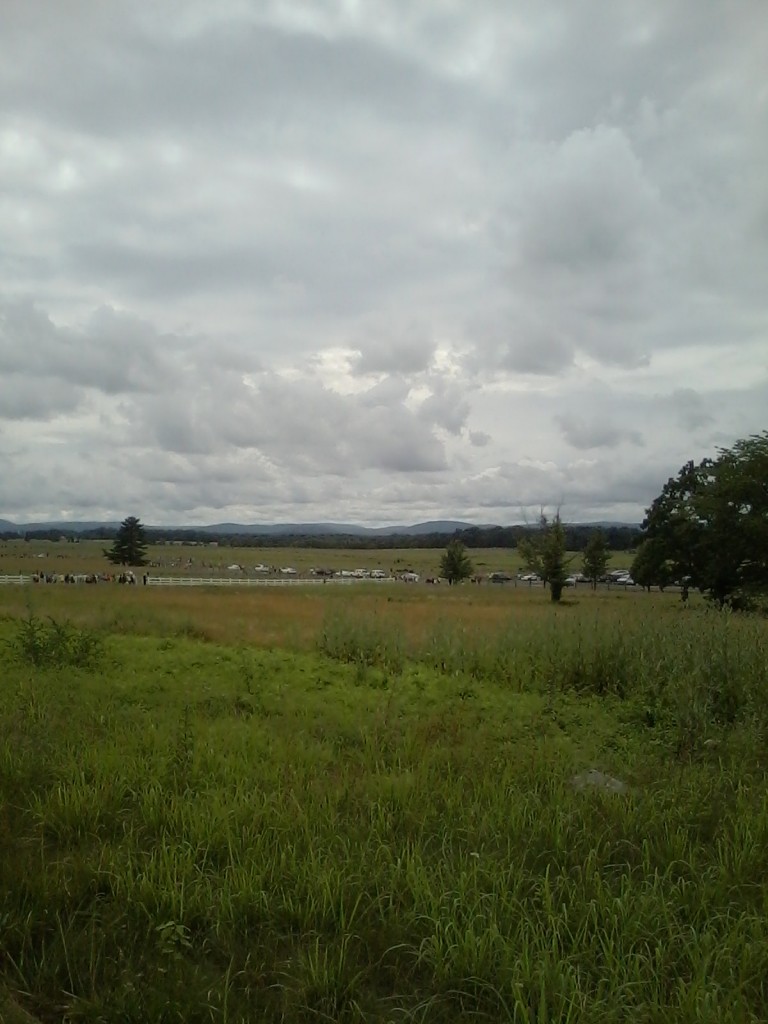
The Union wasn’t worried. 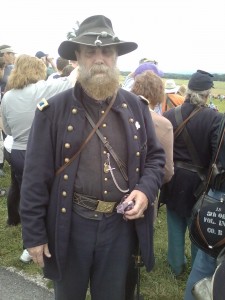
It sort of unfolded in a rather underwhelming manner, 
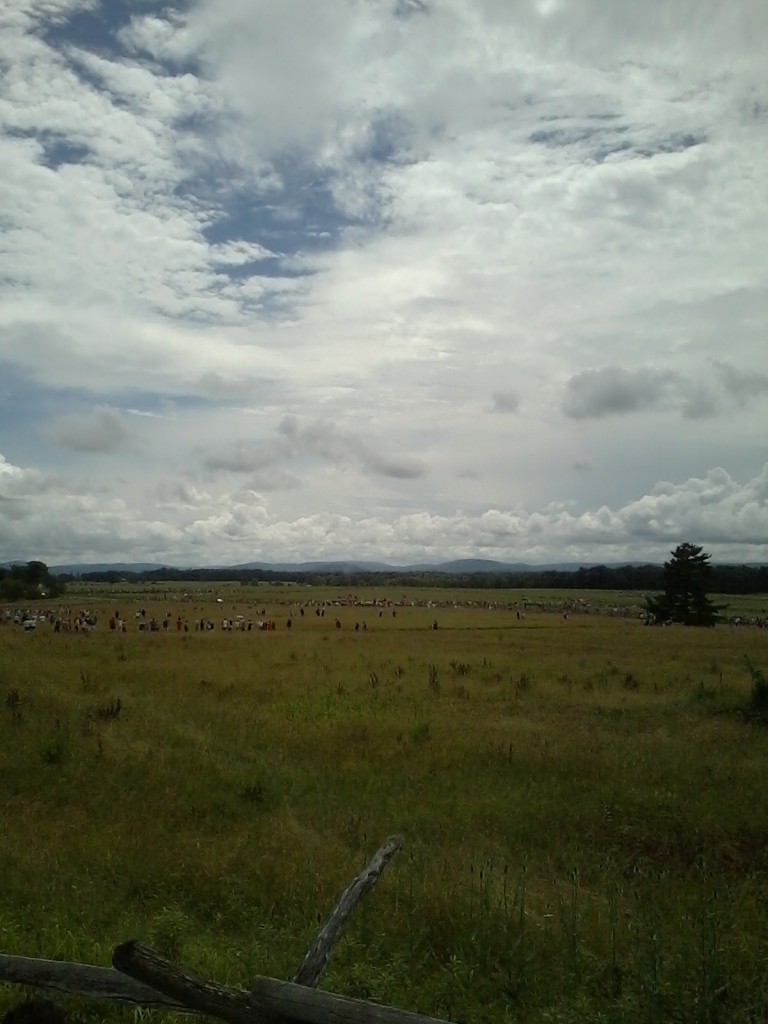
 but got sort of respectable.
but got sort of respectable. 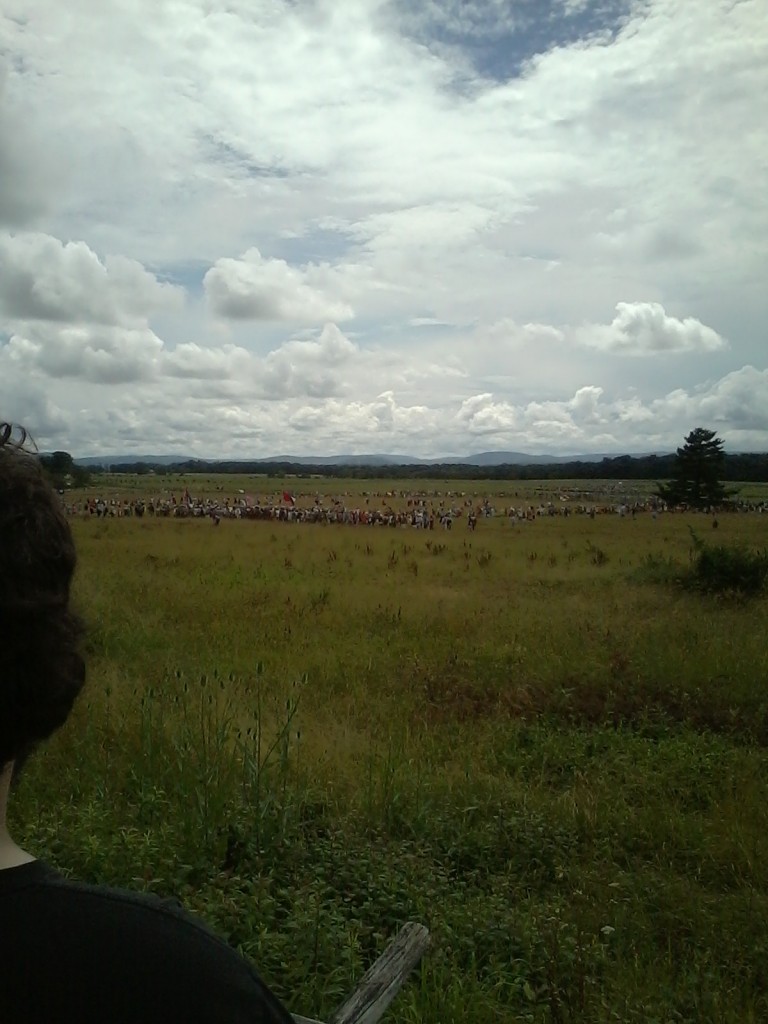
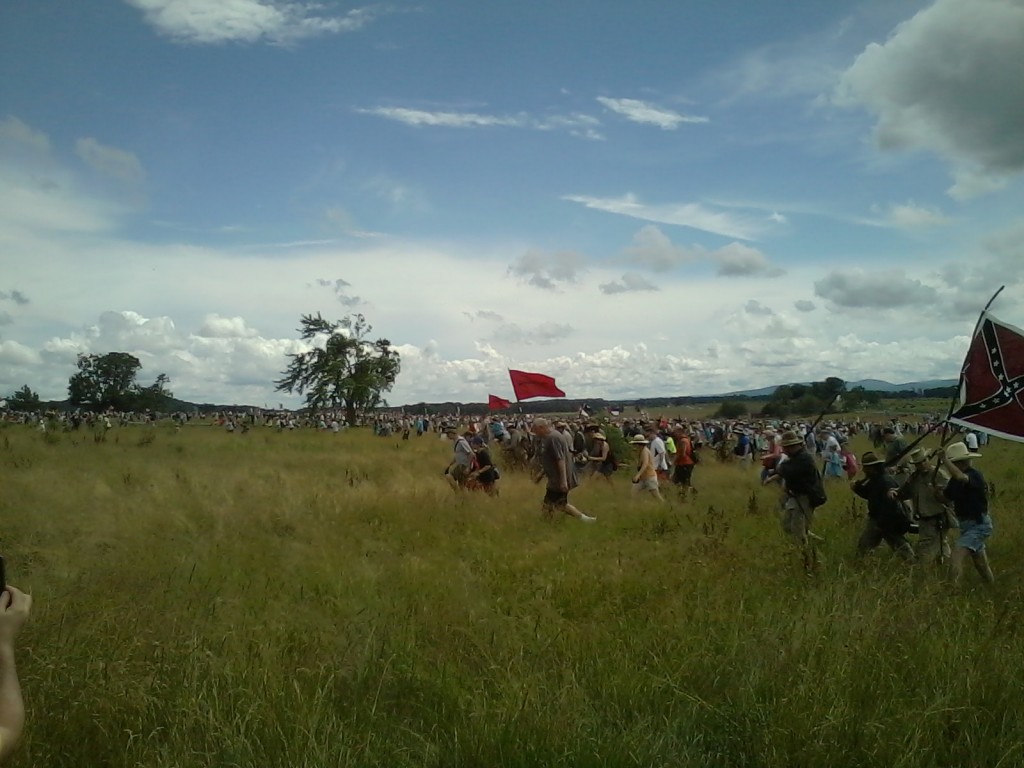
Not exactly the most intimidating group 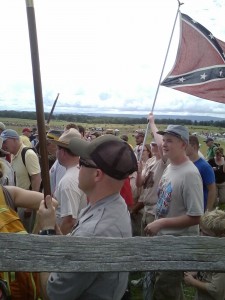
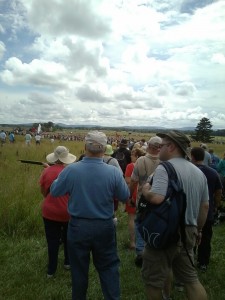 but, hey, fun.
but, hey, fun.
We then ran into the 1st Maryland color guard 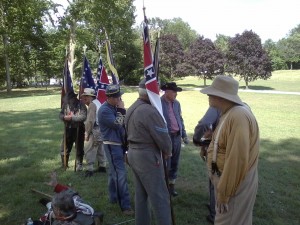 resting under the shade of the trees because it was godawful hot by now and began talking to this guy,
resting under the shade of the trees because it was godawful hot by now and began talking to this guy,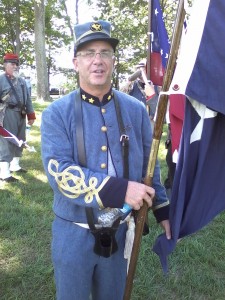 who is a descendant of Snowden Andrews, the 1st Maryland’s artillery chief. He’d been trying for years to buy his ancestor’s artifacts, including Andrews’ frock coat which recently sold at auction for well over $100,000. Why so much? Well, the guy told us this jaw-dropping tale of Snowden getting disemboweled at Cedar Mountain by an artillery round, lying there for four hours as medics passed by going, “He’s toast.” Snowden, apparently, disagreed with that diagnosis and stuffed his intestines back inside himself and then sealed the wound with leaves and grass. Stonewall Jackson’s medical officer thought this demonstrated a will to live and hauled him off to a hospital, where a silver plate was sewn over the wound and the guy survived, was appointed by Lee as his first Secret Service agent and sent to Germany to get arms from the Kaiser, who said Americans were pussies. Snowden showed him his wound, and the Kaiser said, “You can have anything you want.”
who is a descendant of Snowden Andrews, the 1st Maryland’s artillery chief. He’d been trying for years to buy his ancestor’s artifacts, including Andrews’ frock coat which recently sold at auction for well over $100,000. Why so much? Well, the guy told us this jaw-dropping tale of Snowden getting disemboweled at Cedar Mountain by an artillery round, lying there for four hours as medics passed by going, “He’s toast.” Snowden, apparently, disagreed with that diagnosis and stuffed his intestines back inside himself and then sealed the wound with leaves and grass. Stonewall Jackson’s medical officer thought this demonstrated a will to live and hauled him off to a hospital, where a silver plate was sewn over the wound and the guy survived, was appointed by Lee as his first Secret Service agent and sent to Germany to get arms from the Kaiser, who said Americans were pussies. Snowden showed him his wound, and the Kaiser said, “You can have anything you want.”
Wow.
We also ran into the rest of the Orphan Brigade 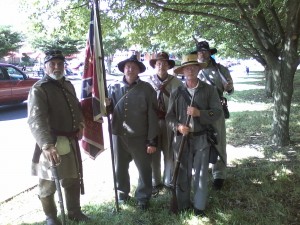 (made so by a dearth of participants), and a falcon on top of a telephone pole
(made so by a dearth of participants), and a falcon on top of a telephone pole 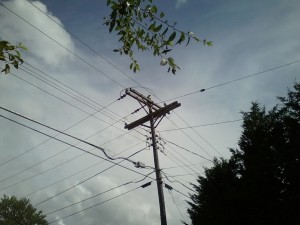 who was letting the world know he was not happy about this situation, not at all.
who was letting the world know he was not happy about this situation, not at all.
We then headed off to Little Round Top because you just can’t visit Gettysburg without doing so 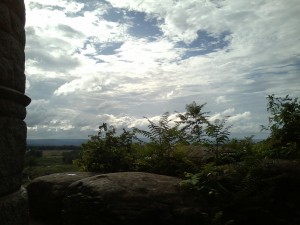 At the bottom of the hill,
At the bottom of the hill, 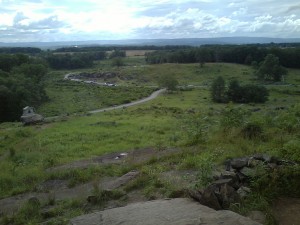 we ran into members of the 124th New York and their ladies, piled them into the back of the pickup and took them up the hill, for which they were quite grateful.
we ran into members of the 124th New York and their ladies, piled them into the back of the pickup and took them up the hill, for which they were quite grateful. 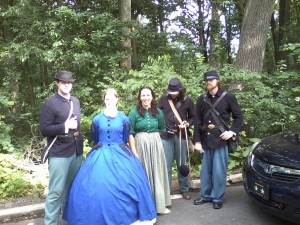 Doing our part to support the troops.
Doing our part to support the troops.
We then headed off to a little known part of the 1st Day’s Battle called the Brickyard. We ran into elements of the 154th New York there, including this guy, who is a descendant of Benjamin Hotchkiss, the inventor of the Hotchkiss gun, and had another ancestor in the 154th. He told us the 154th and others, about 890 men, took position behind a picket fence located between the two markers
who is a descendant of Benjamin Hotchkiss, the inventor of the Hotchkiss gun, and had another ancestor in the 154th. He told us the 154th and others, about 890 men, took position behind a picket fence located between the two markers 
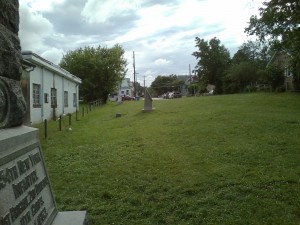 in ranks about 8-9 deep, in an attempt to stop the Confederate charge through Gettysburg. The first line would fire, fall back, second line would step up, fire, fall back, etc, and things were going pretty good until they ran out of ammunition. They got slaughtered. The unit pretty much ceased to exist.
in ranks about 8-9 deep, in an attempt to stop the Confederate charge through Gettysburg. The first line would fire, fall back, second line would step up, fire, fall back, etc, and things were going pretty good until they ran out of ammunition. They got slaughtered. The unit pretty much ceased to exist.
The mural on the side of the building depicts all. 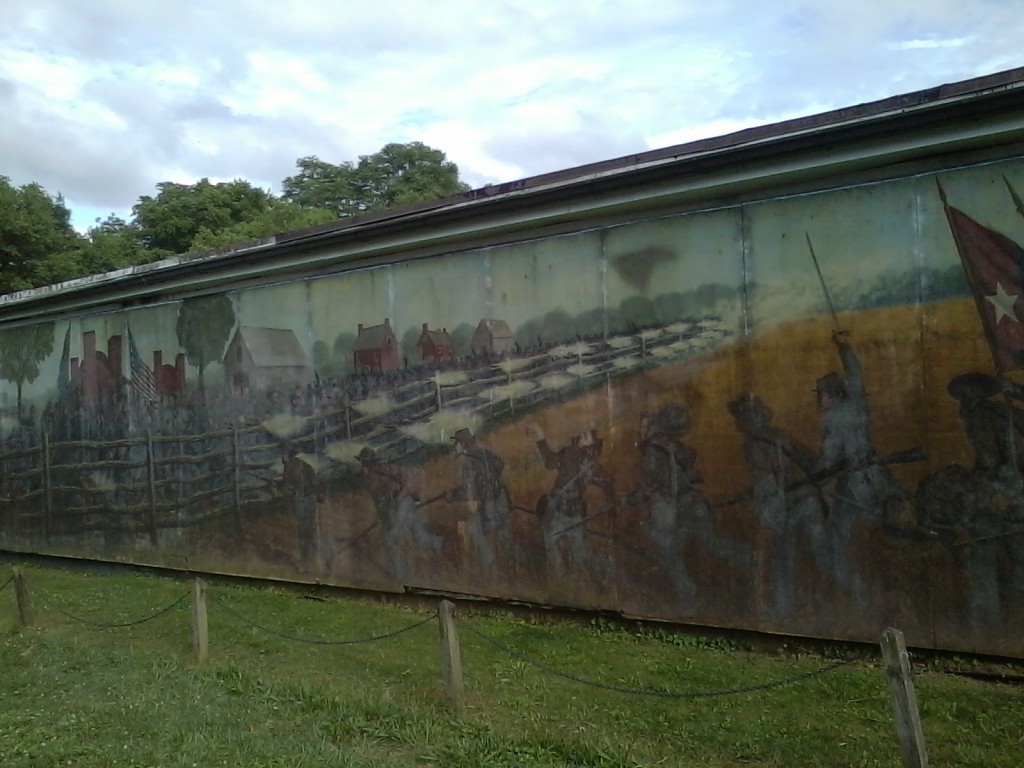

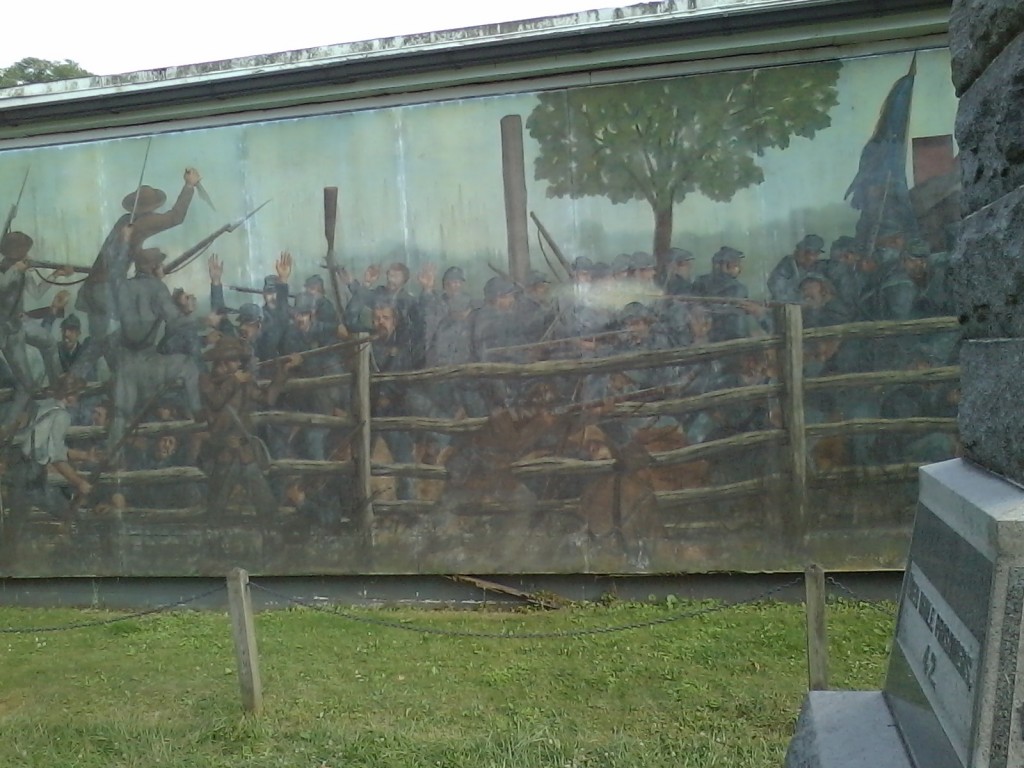
And, with that, we were done.
We stopped at an Italian restaurant (that’s what the sign said) because I was too beat to cook. Man, getting old is hell. We put on an amazingly good campfire (finally), crashed, got up the next morning, made coffee, packed up, and went home, where I lay in a stupor for the next two days.
I need another vacation.
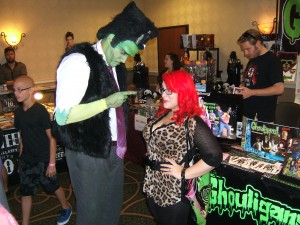
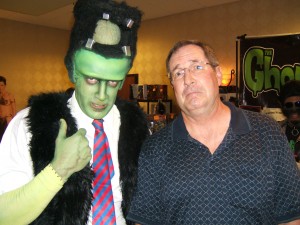
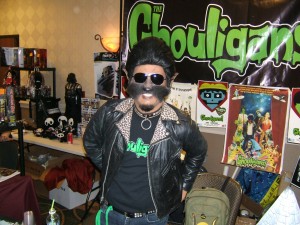
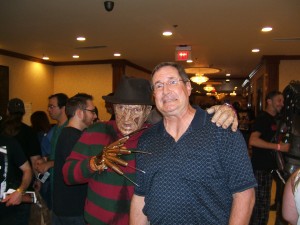
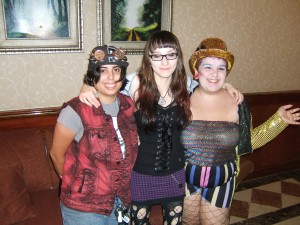 Nor about this:
Nor about this: 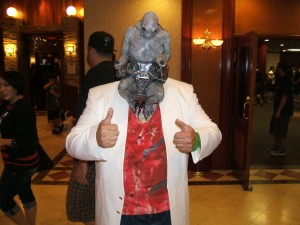
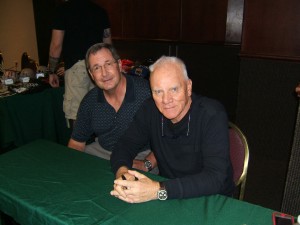 We talked about Community, which is the funniest TV show ever and in the future, and on which McDowell plays an insane history teacher. I suggested that he and Betty White team teach a class, which should make Abed’s head explode. McDowell loves Betty White.
We talked about Community, which is the funniest TV show ever and in the future, and on which McDowell plays an insane history teacher. I suggested that he and Betty White team teach a class, which should make Abed’s head explode. McDowell loves Betty White.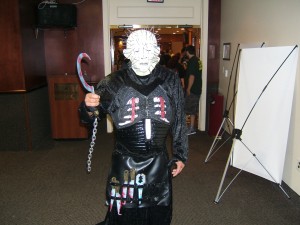 Not sure, but I like it.
Not sure, but I like it. 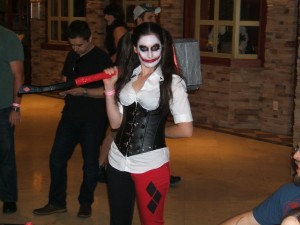



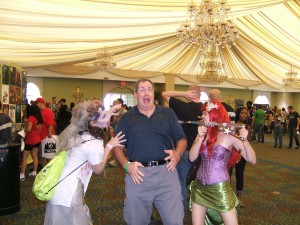 I got away.
I got away.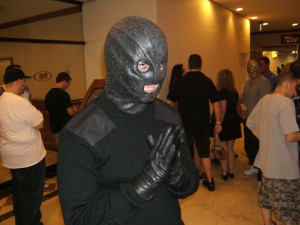 but this is Captain Sparrow,
but this is Captain Sparrow,  who wanted compensation for me taking his picture. Captain Dickhead.
who wanted compensation for me taking his picture. Captain Dickhead.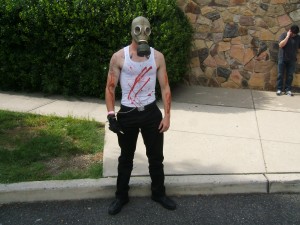 Thank God there was a priest.
Thank God there was a priest. 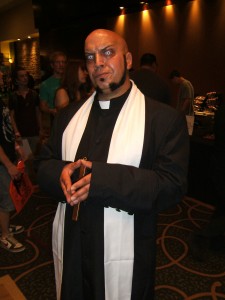 Pray with me, in my hour of bleed…
Pray with me, in my hour of bleed…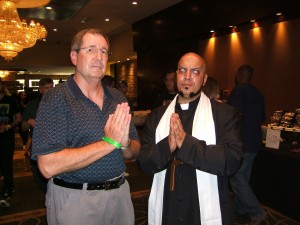
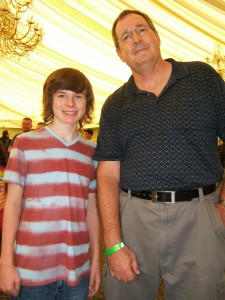 Carl on The Walking Dead. He should do something about the girl in the bloody bathrobe, ’cause it looks like she’s about to turn.
Carl on The Walking Dead. He should do something about the girl in the bloody bathrobe, ’cause it looks like she’s about to turn. 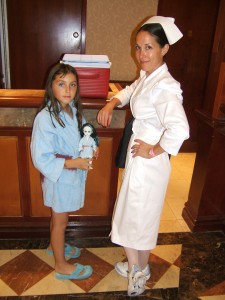 I’ll rescue the nurse, Chandler.
I’ll rescue the nurse, Chandler. Christopher Lloyd, put’er on’er of various roles.
Christopher Lloyd, put’er on’er of various roles. 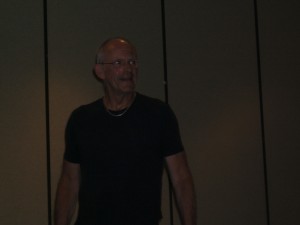 He had an hour long Q&A. When he played Jim Ignatowski, he was not acting. Trust me on this.
He had an hour long Q&A. When he played Jim Ignatowski, he was not acting. Trust me on this. They invited me to the midnight showing but, no. No thanks.
They invited me to the midnight showing but, no. No thanks.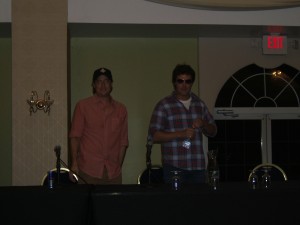 Jeremy London is the guy with the vampire eyes. This was supposed to be a Q&A, but, instead, was an hour long riff-and-improv, mostly by Sheridan, which had me falling off my chair laughing my butt off (screw the acronym). I did not tape it. I wish I had.
Jeremy London is the guy with the vampire eyes. This was supposed to be a Q&A, but, instead, was an hour long riff-and-improv, mostly by Sheridan, which had me falling off my chair laughing my butt off (screw the acronym). I did not tape it. I wish I had.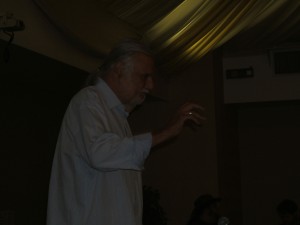 Q&As. I did record those, and as soon as I figure out how to upload the videos, I’ll post them. I suck at video.
Q&As. I did record those, and as soon as I figure out how to upload the videos, I’ll post them. I suck at video.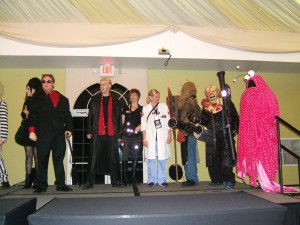
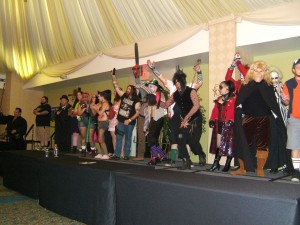
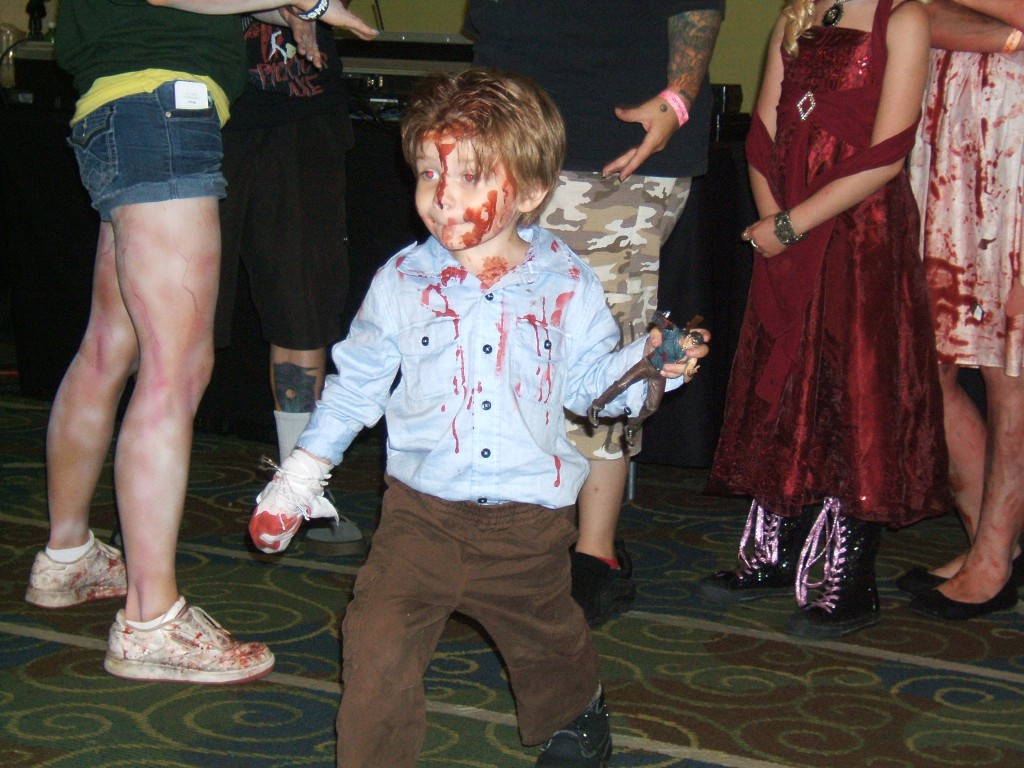 He’s three. I’m sure he’ll grow up fine.
He’s three. I’m sure he’ll grow up fine.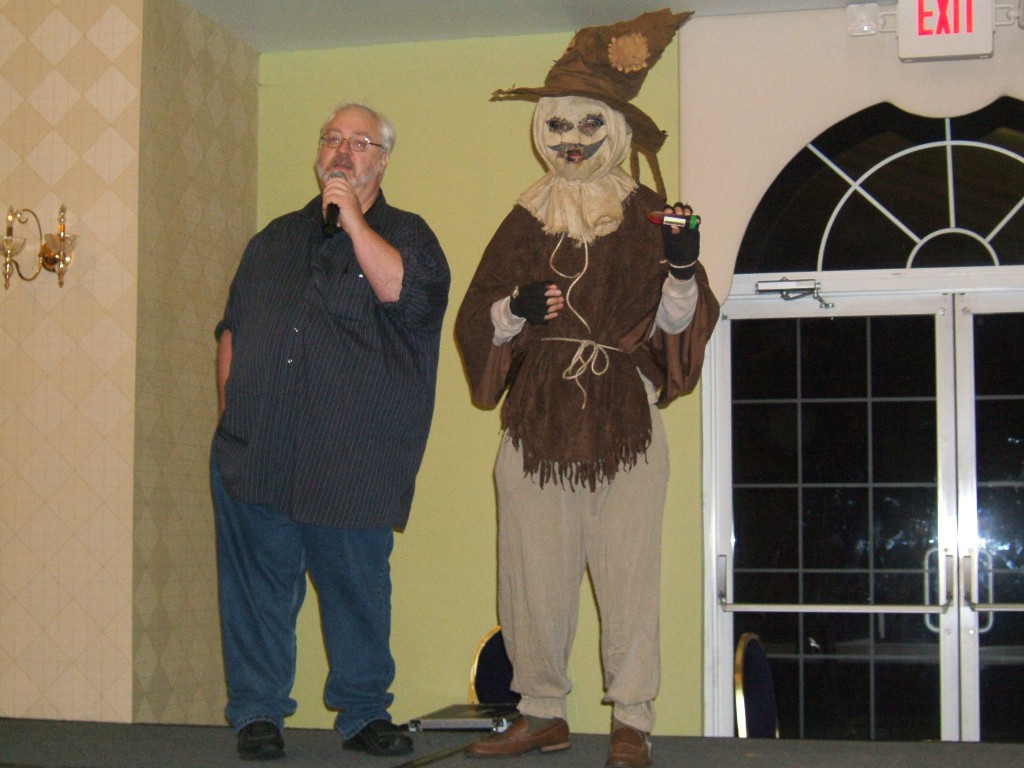 I’m sure he’ll be okay when he grows up, too. The kid, I mean.
I’m sure he’ll be okay when he grows up, too. The kid, I mean. That’s what she called herself, so there.
That’s what she called herself, so there. Tied with Yip-Yip.
Tied with Yip-Yip. 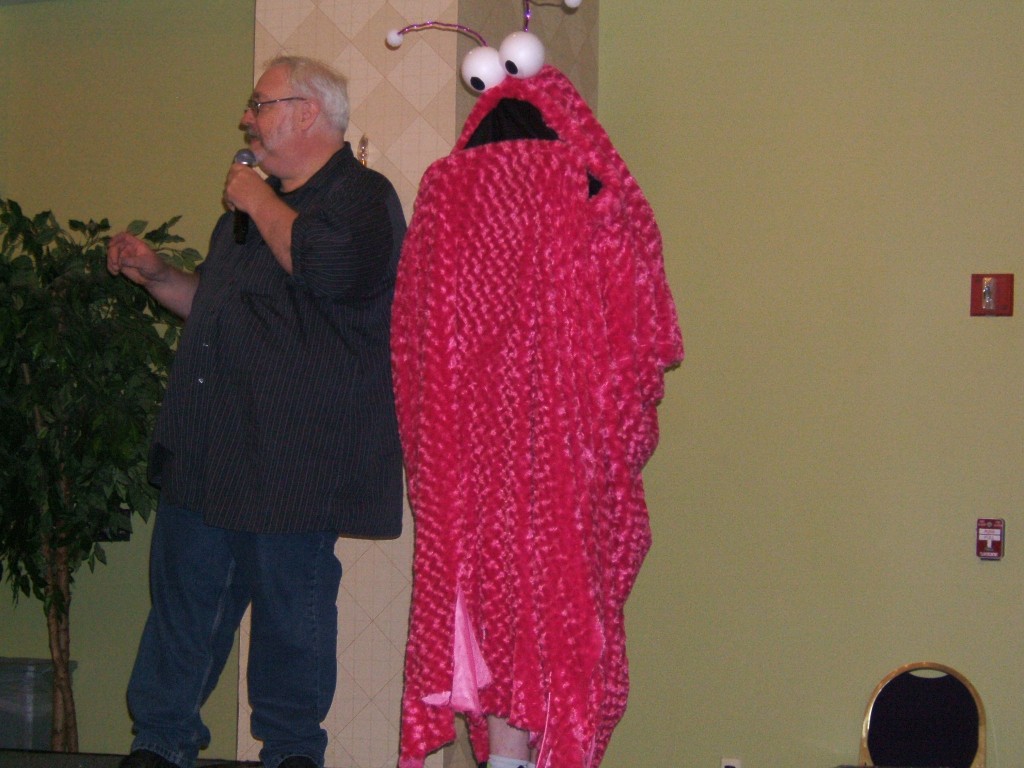
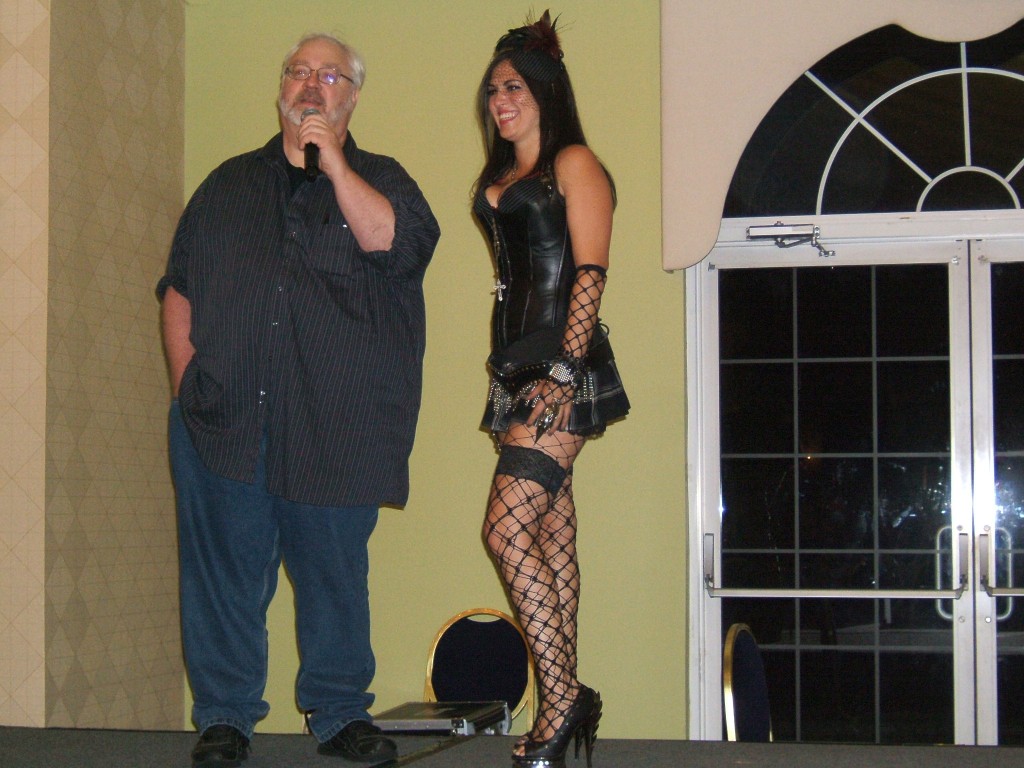 I had a tie vote with Nurse Jasmine
I had a tie vote with Nurse Jasmine  and Punk Arial
and Punk Arial 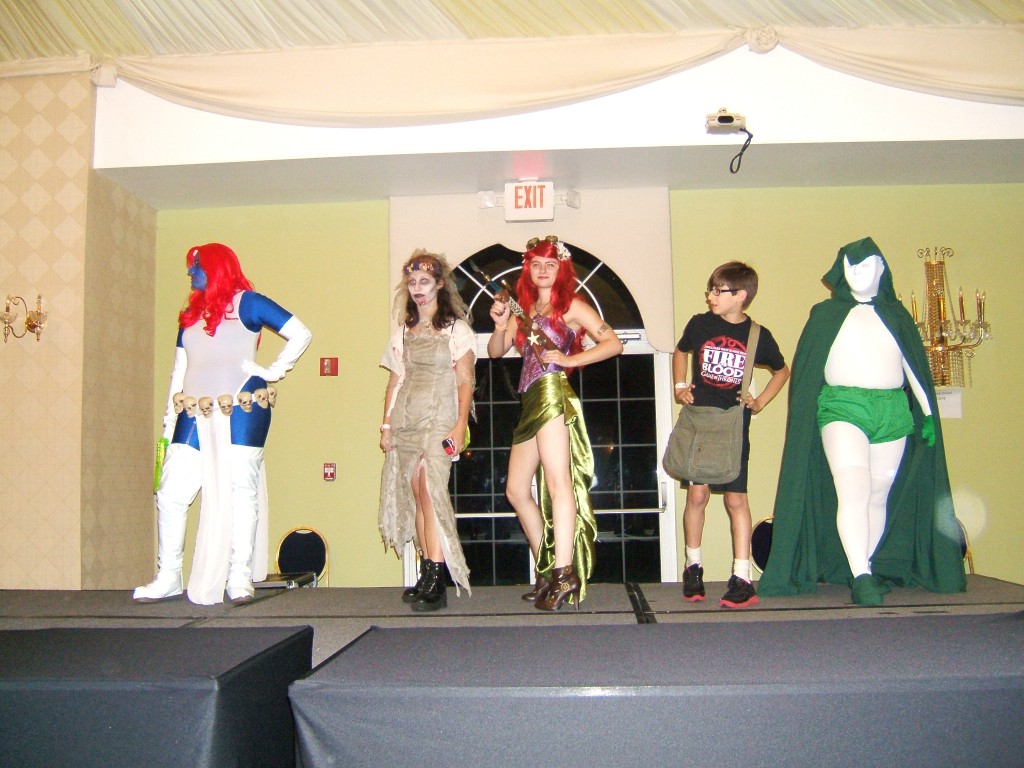 even though she tried to kill me earlier.
even though she tried to kill me earlier.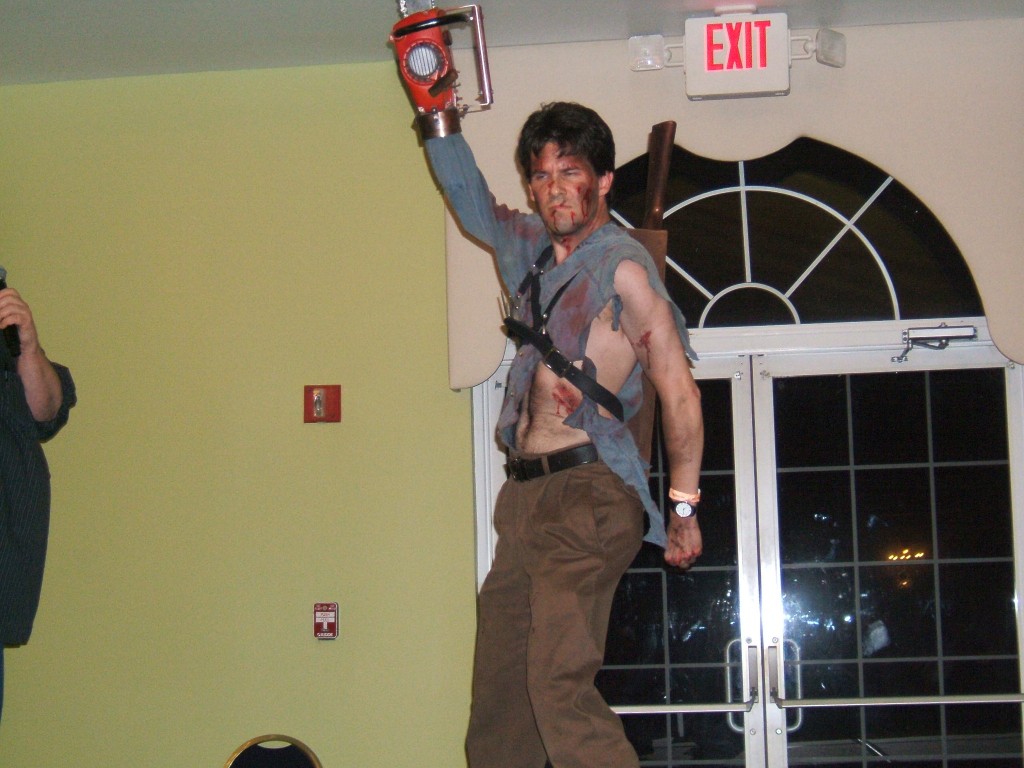 Freddy vs Jason,
Freddy vs Jason, 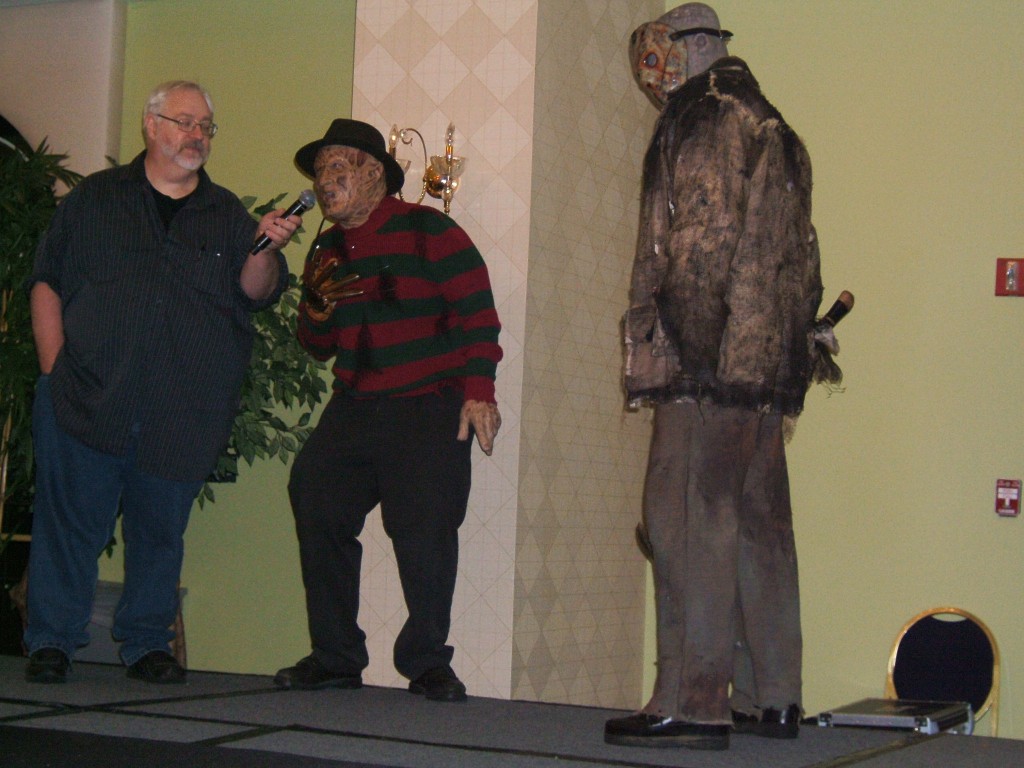 who won first place in the Scariest category, and a female Cenobite,
who won first place in the Scariest category, and a female Cenobite, 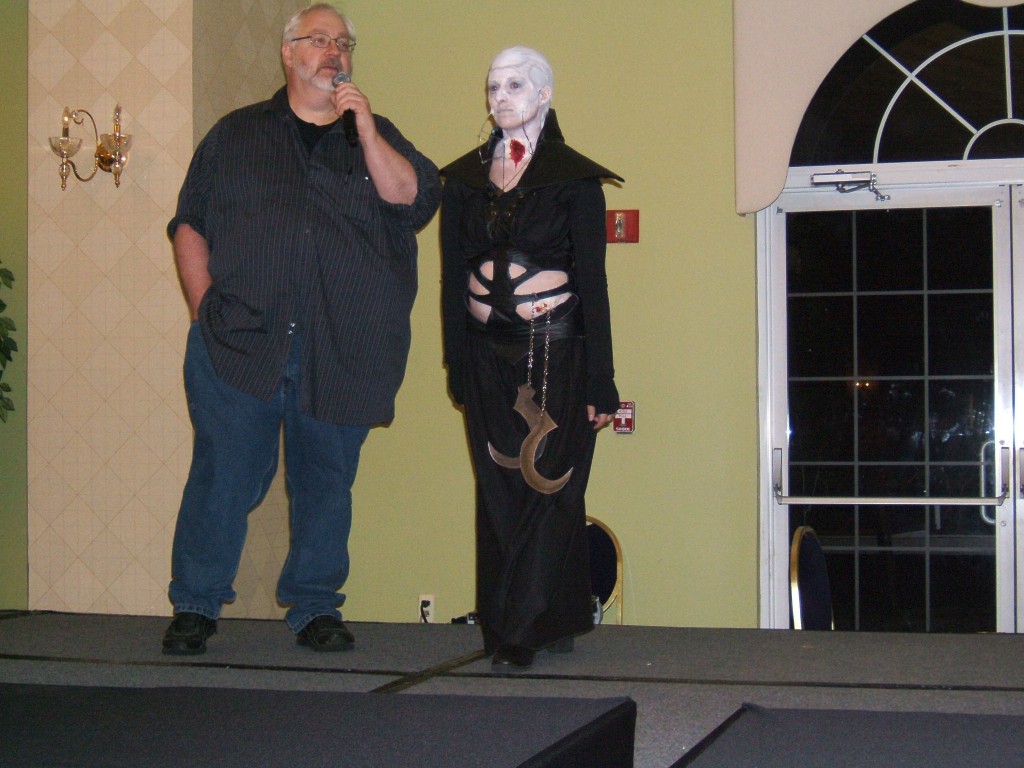 who should have won first place in the Scariest category. And the Sexiest. Yes, there’s something wrong with me.
who should have won first place in the Scariest category. And the Sexiest. Yes, there’s something wrong with me.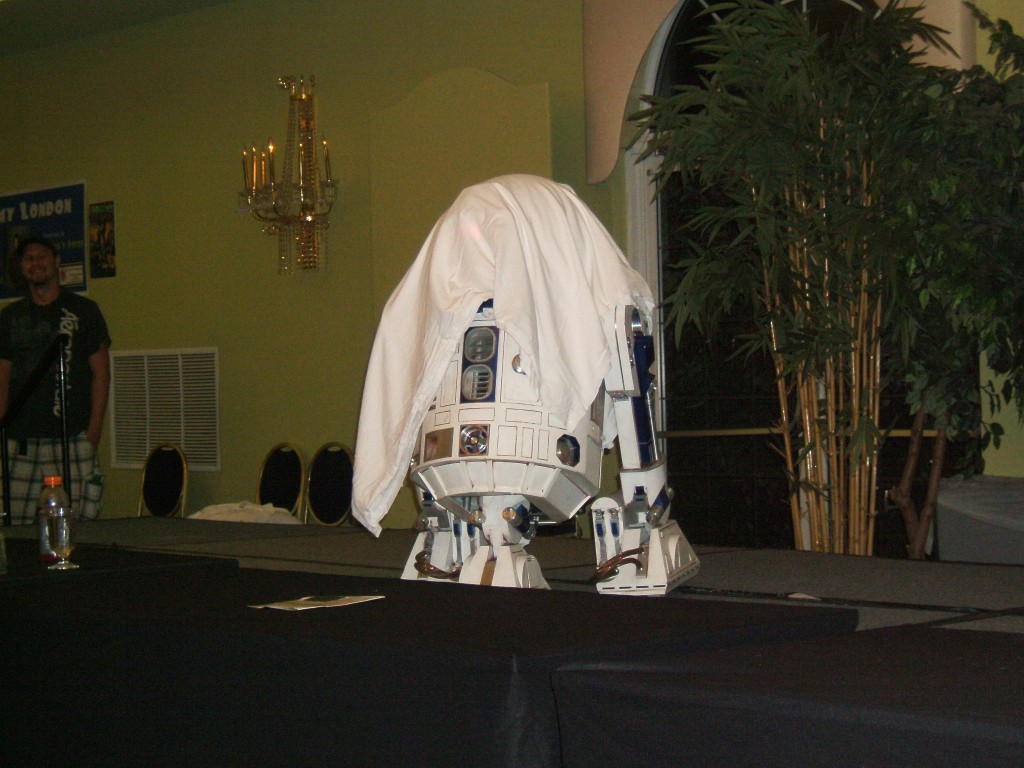
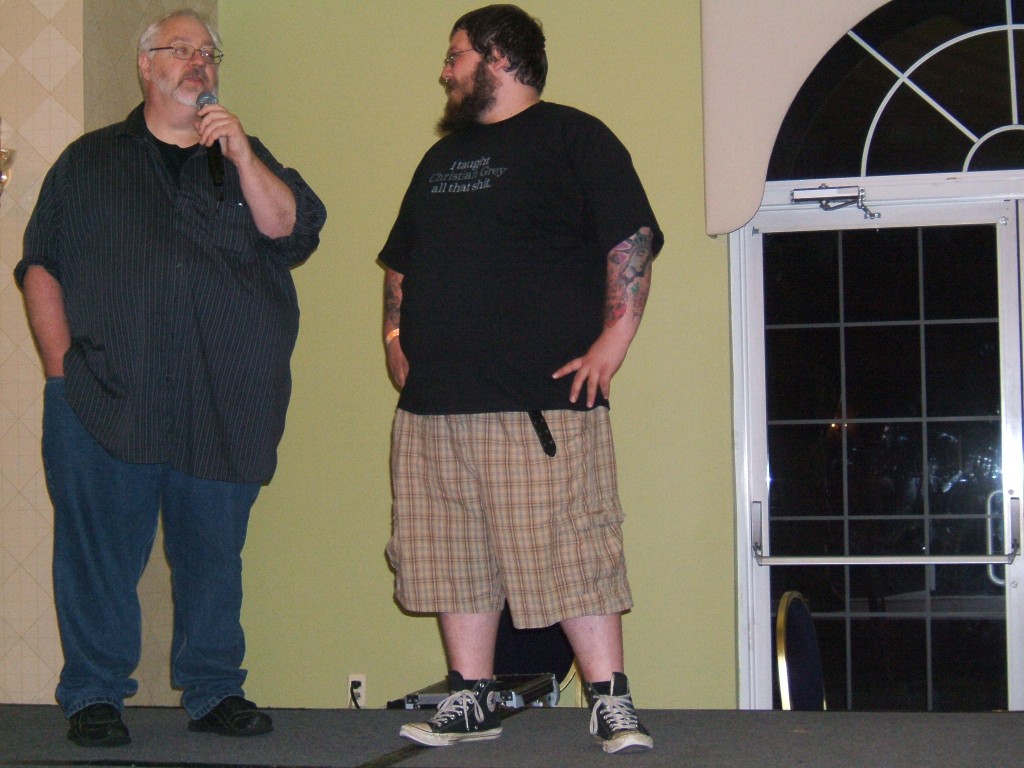
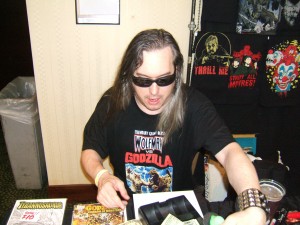 who signed my copy of ’68 and thanked me for my service, even though I missed Vietnam by about five days. Refreshing.
who signed my copy of ’68 and thanked me for my service, even though I missed Vietnam by about five days. Refreshing.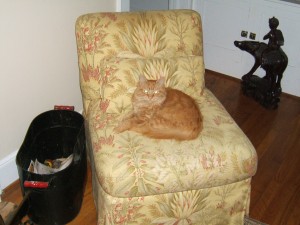 and the pod had reached maturity.
and the pod had reached maturity. 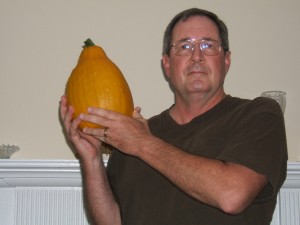 I don’t know if it’s a squampkin or a pumquash,
I don’t know if it’s a squampkin or a pumquash,  but I swear there’s a person inside.
but I swear there’s a person inside.
